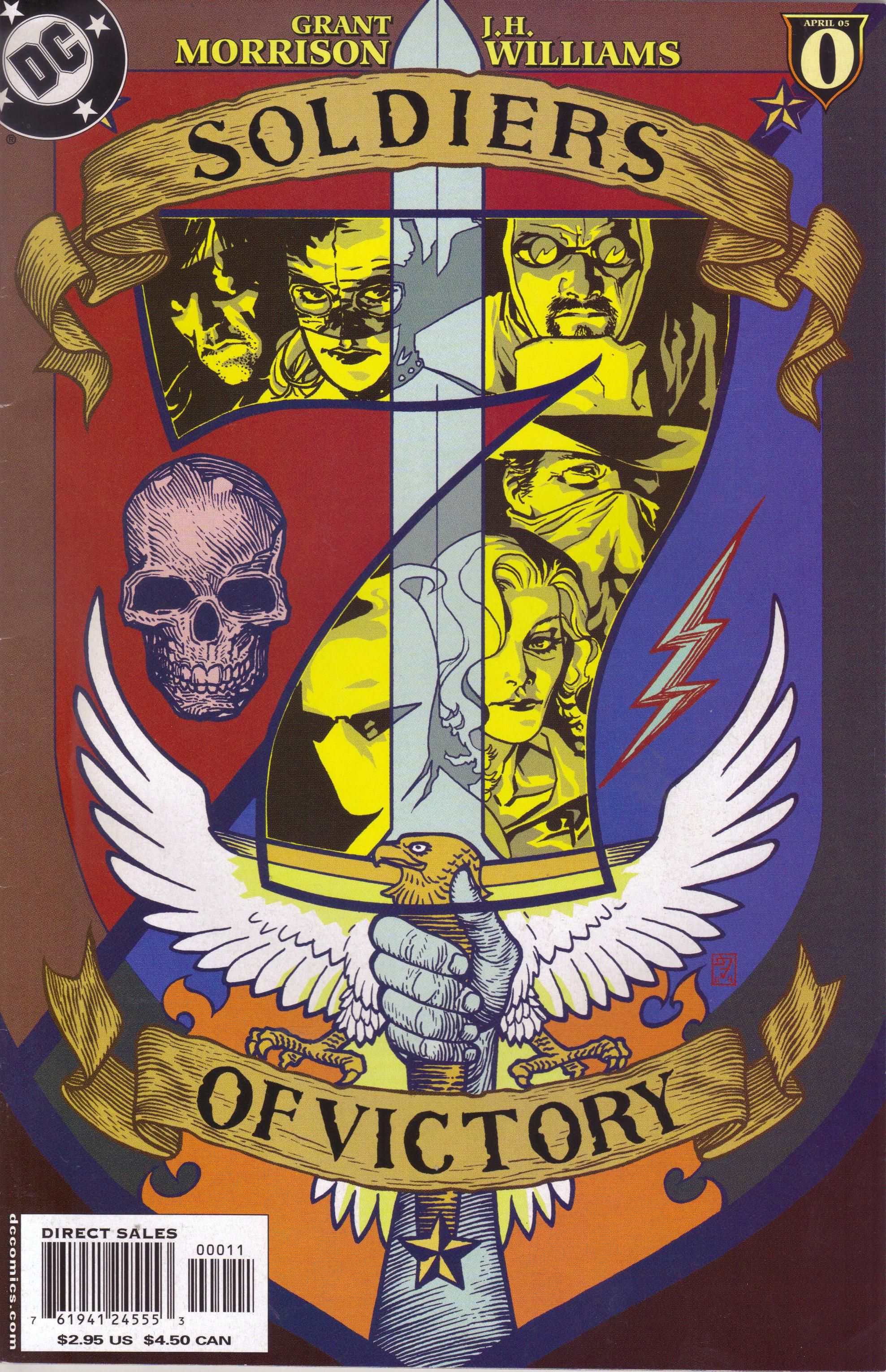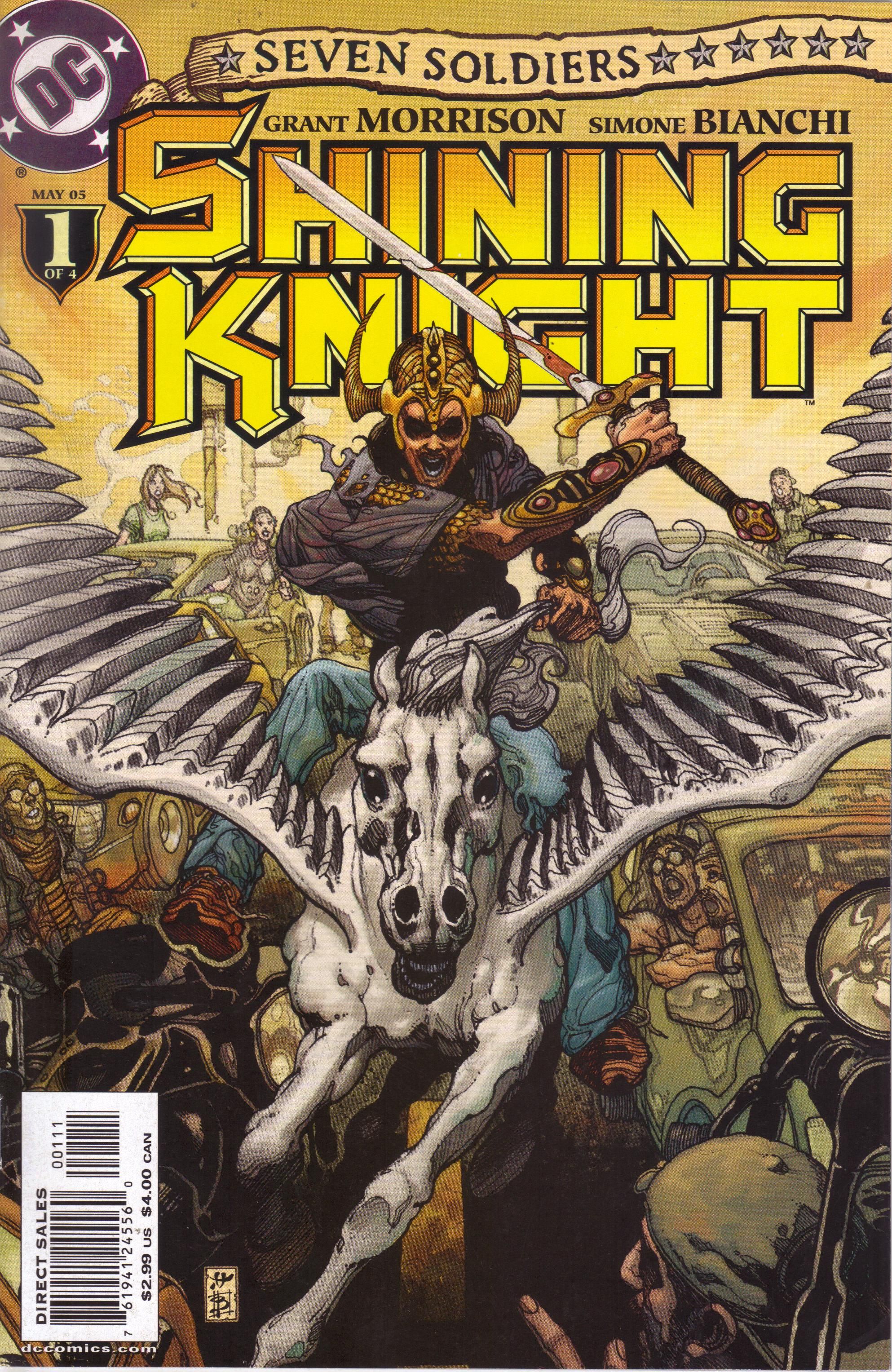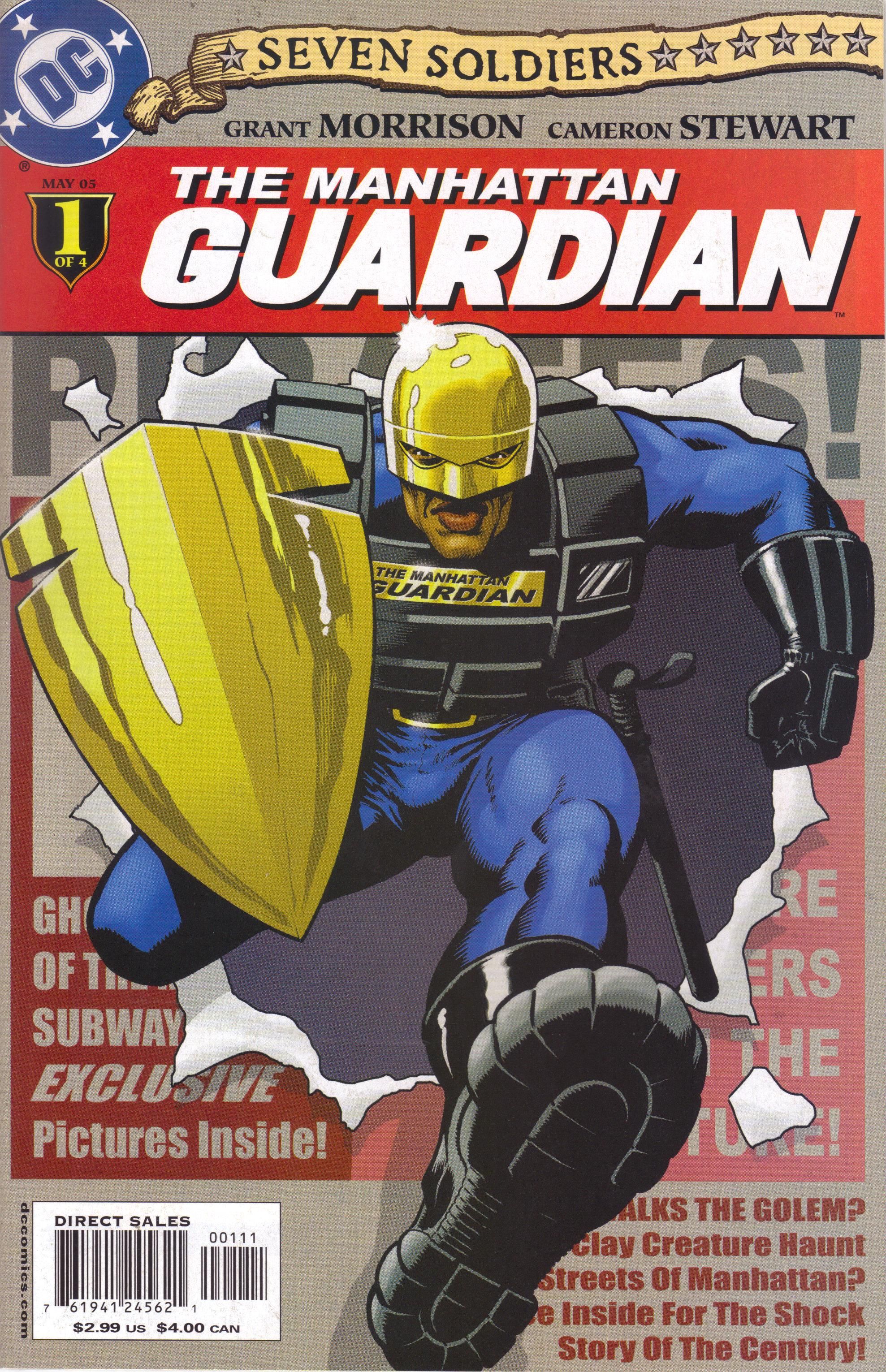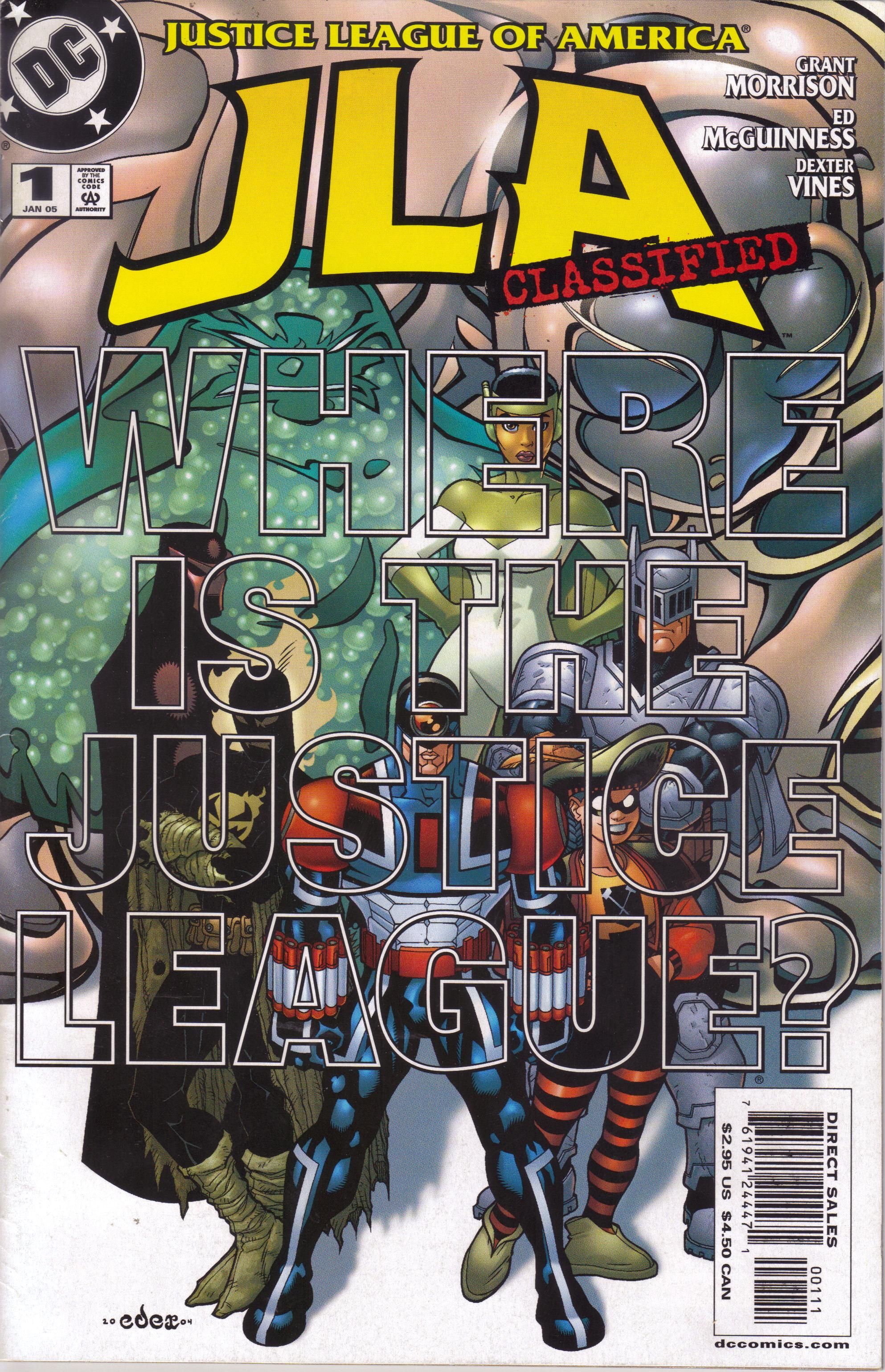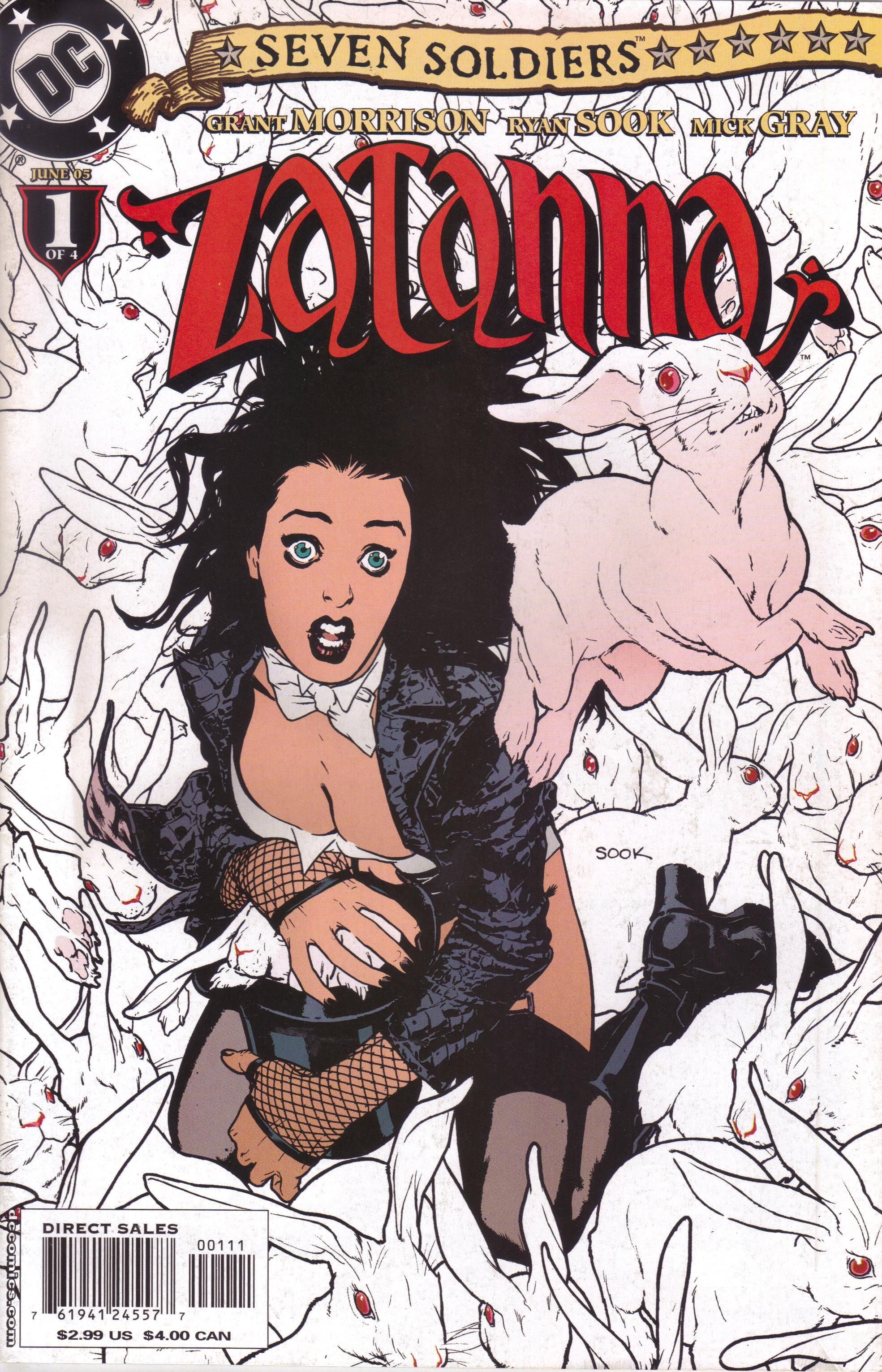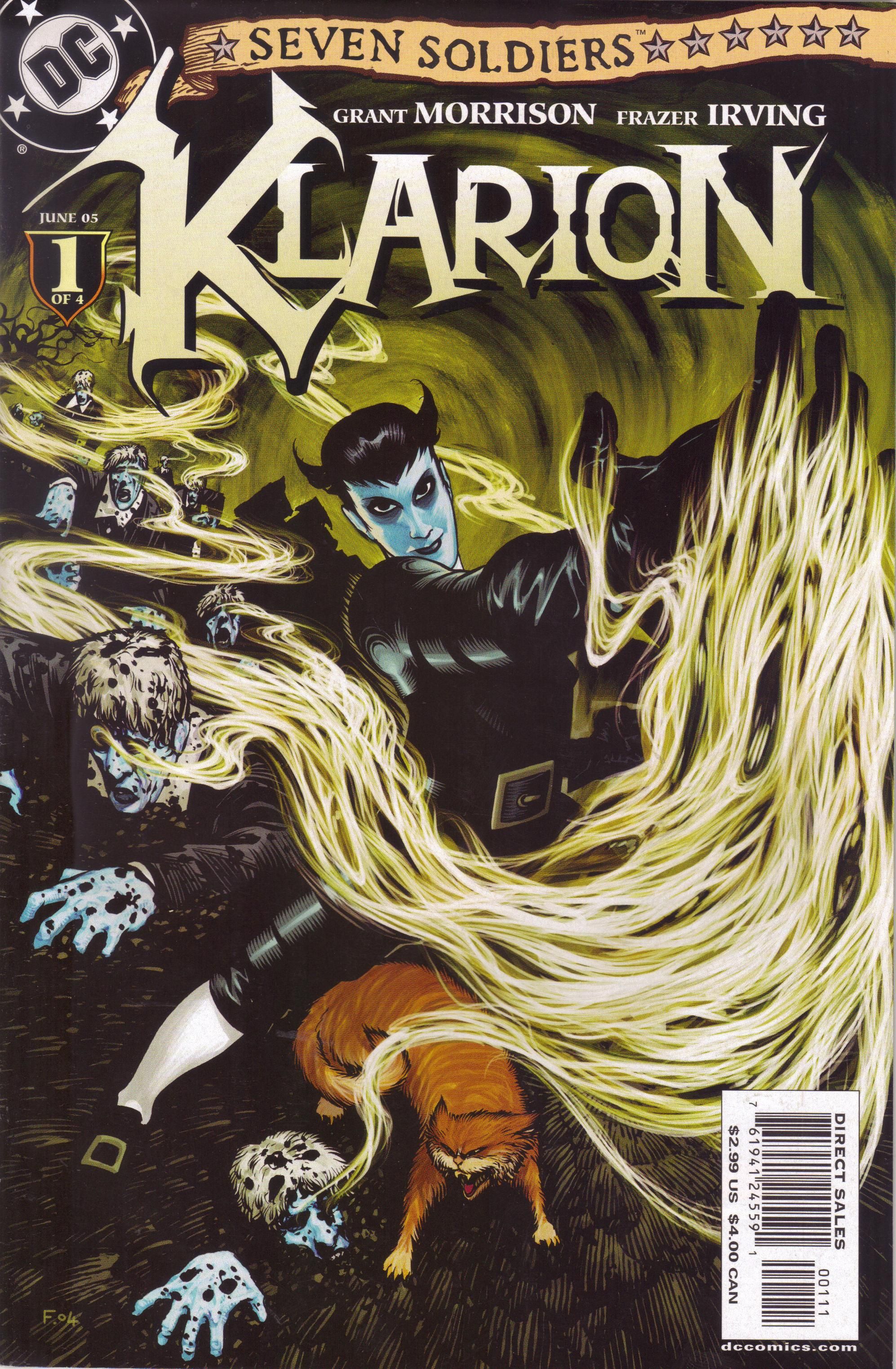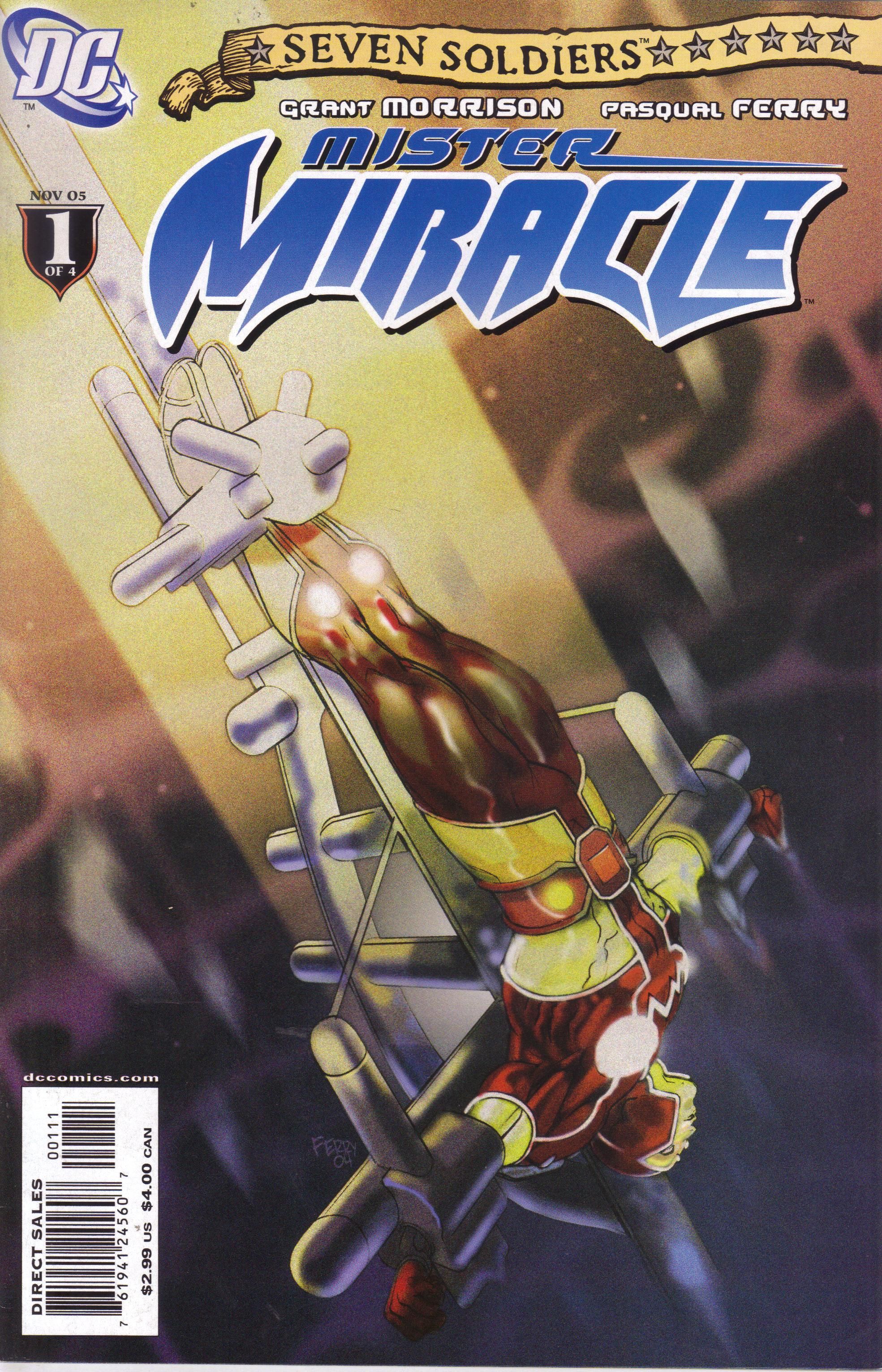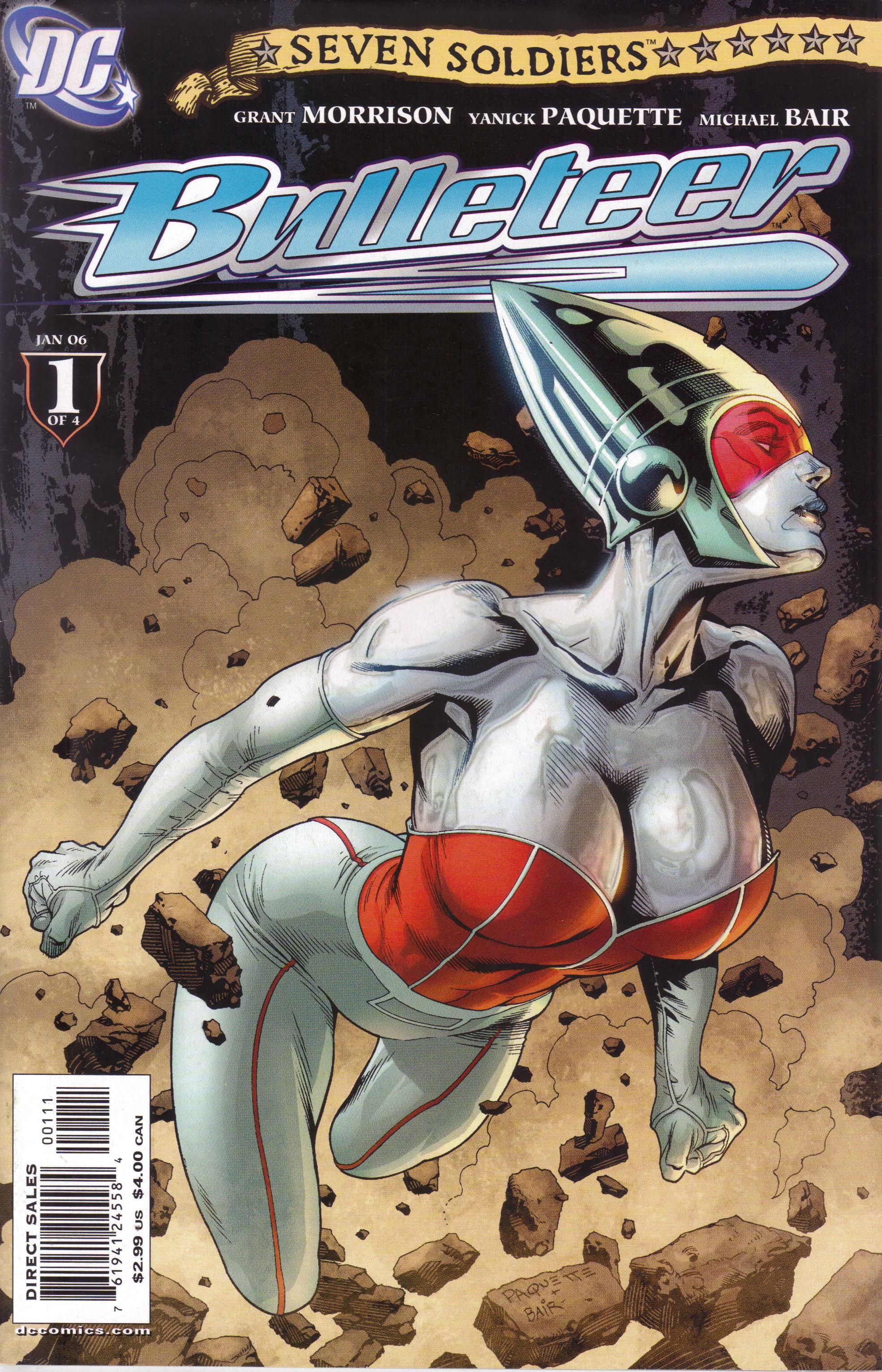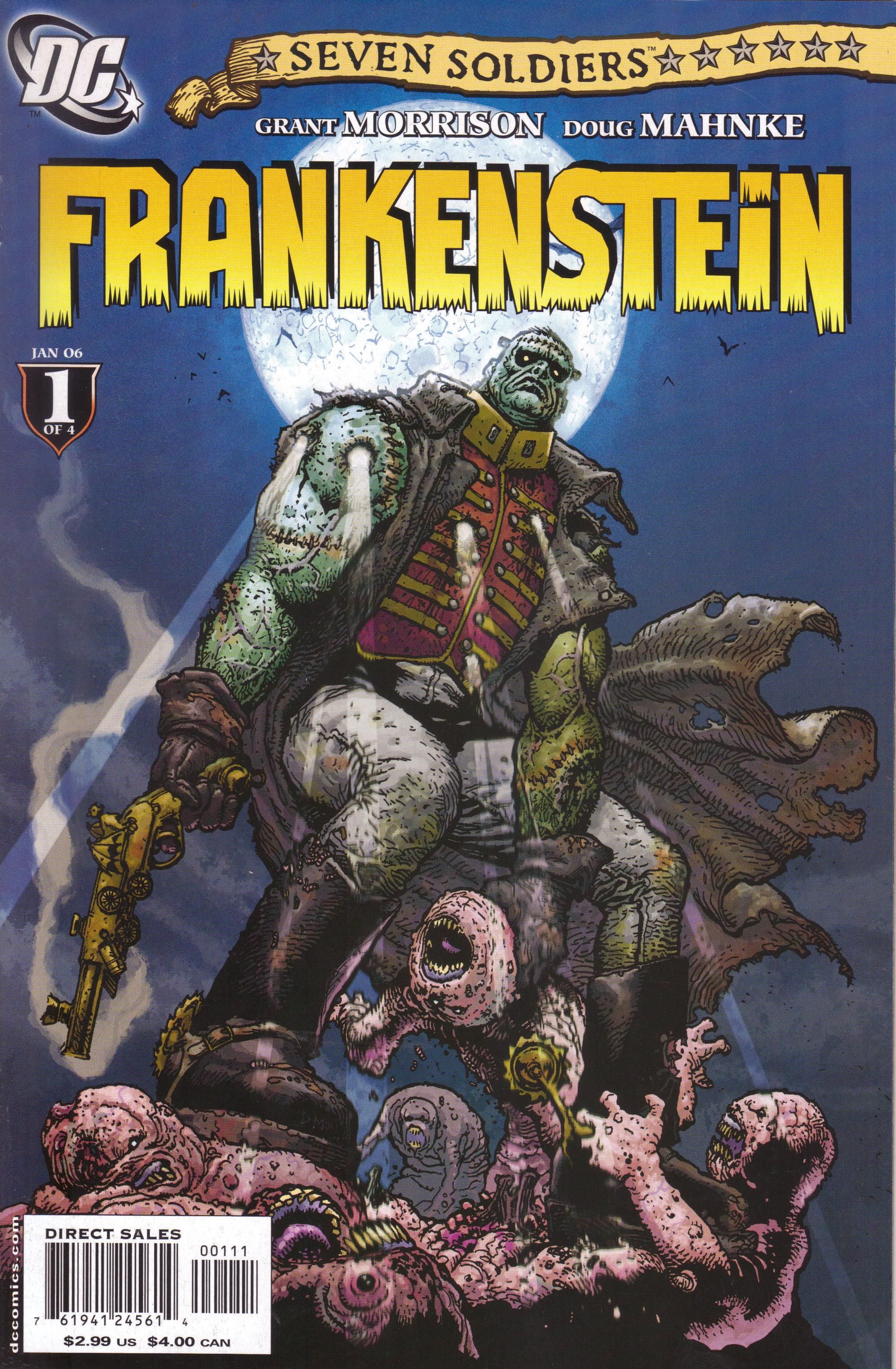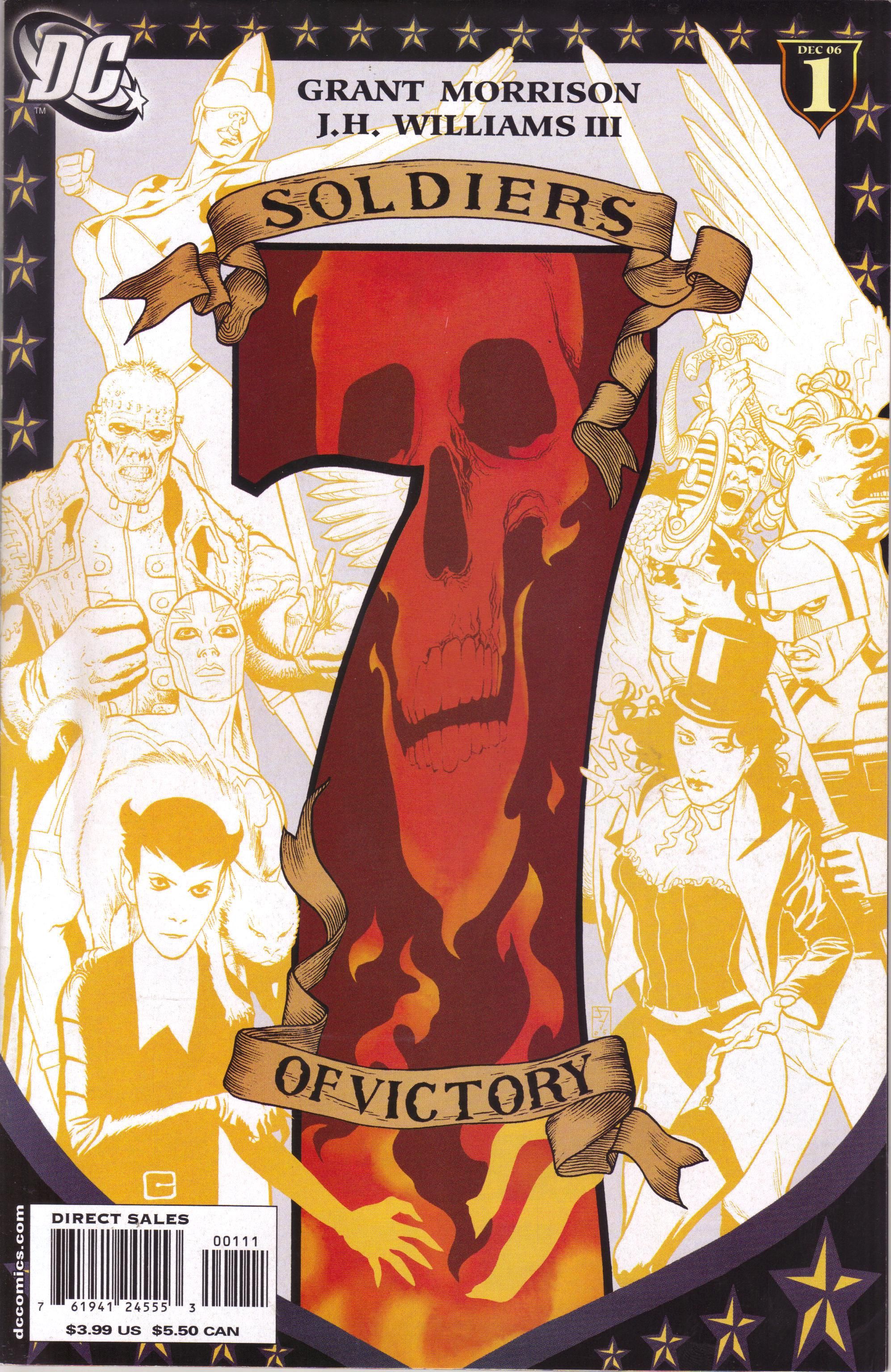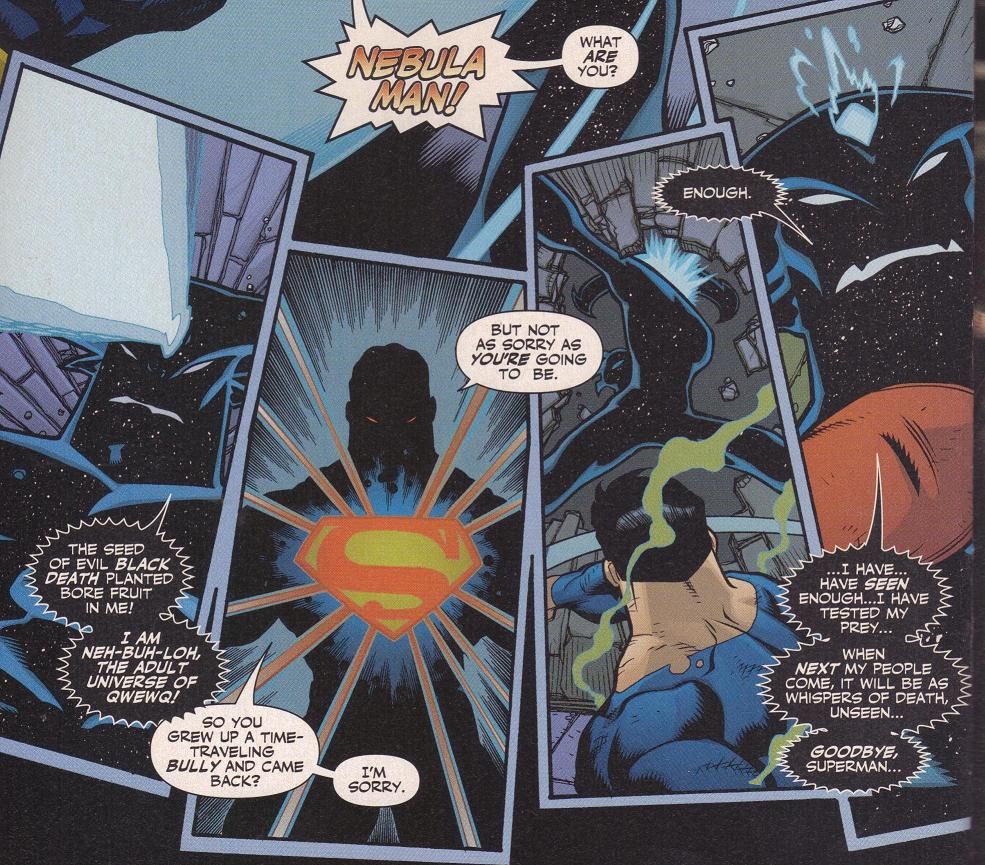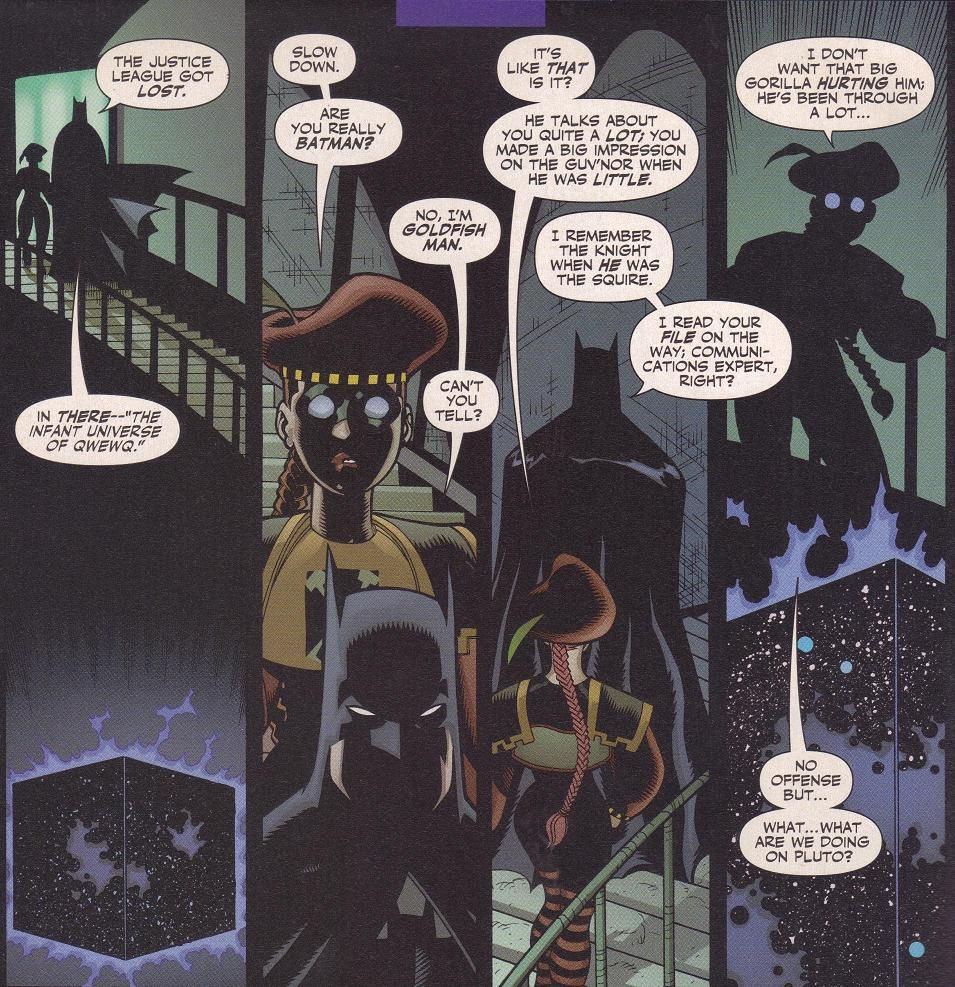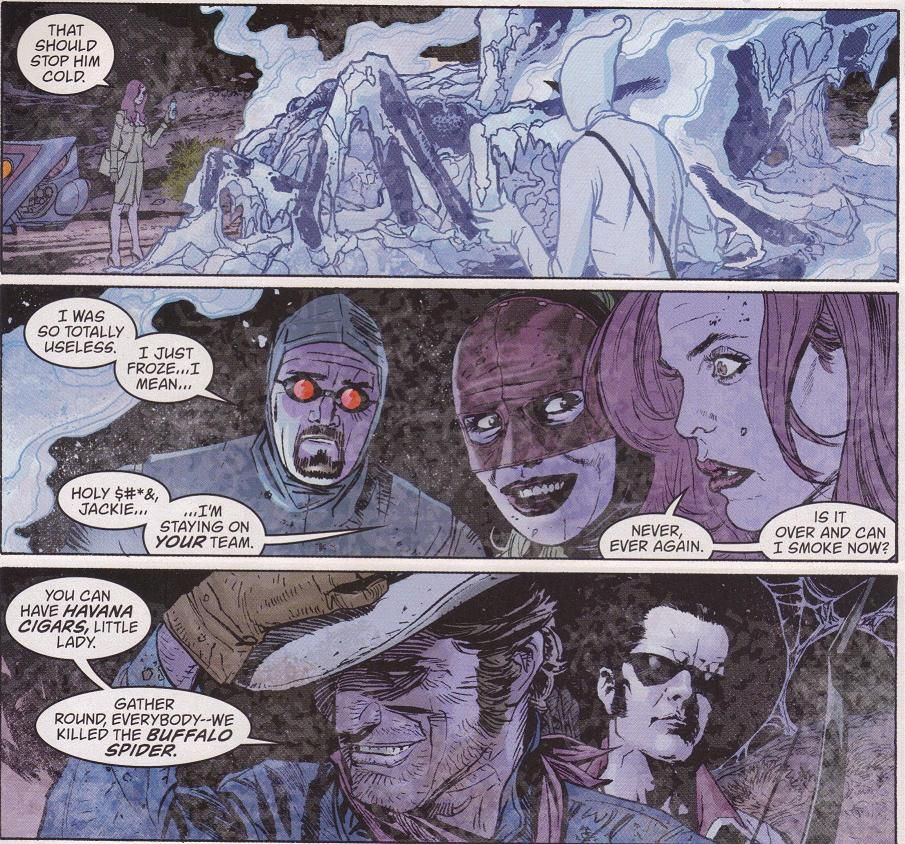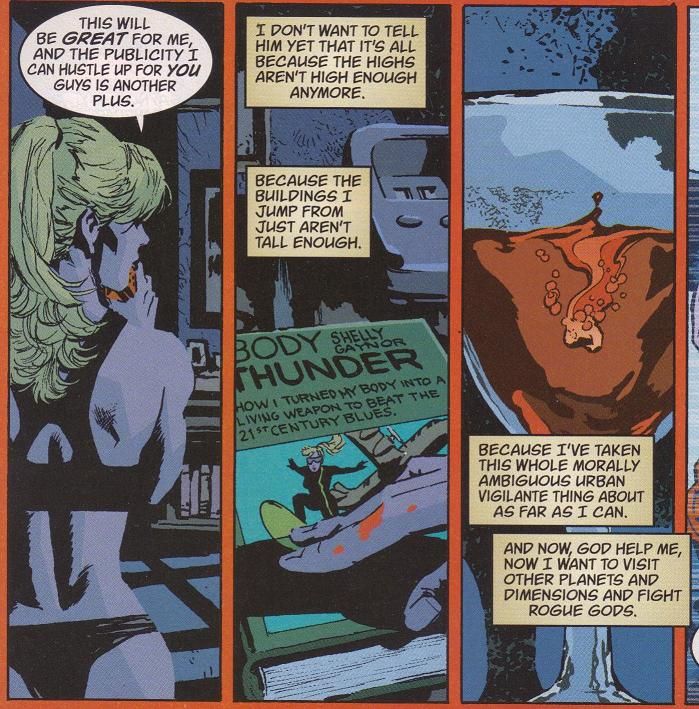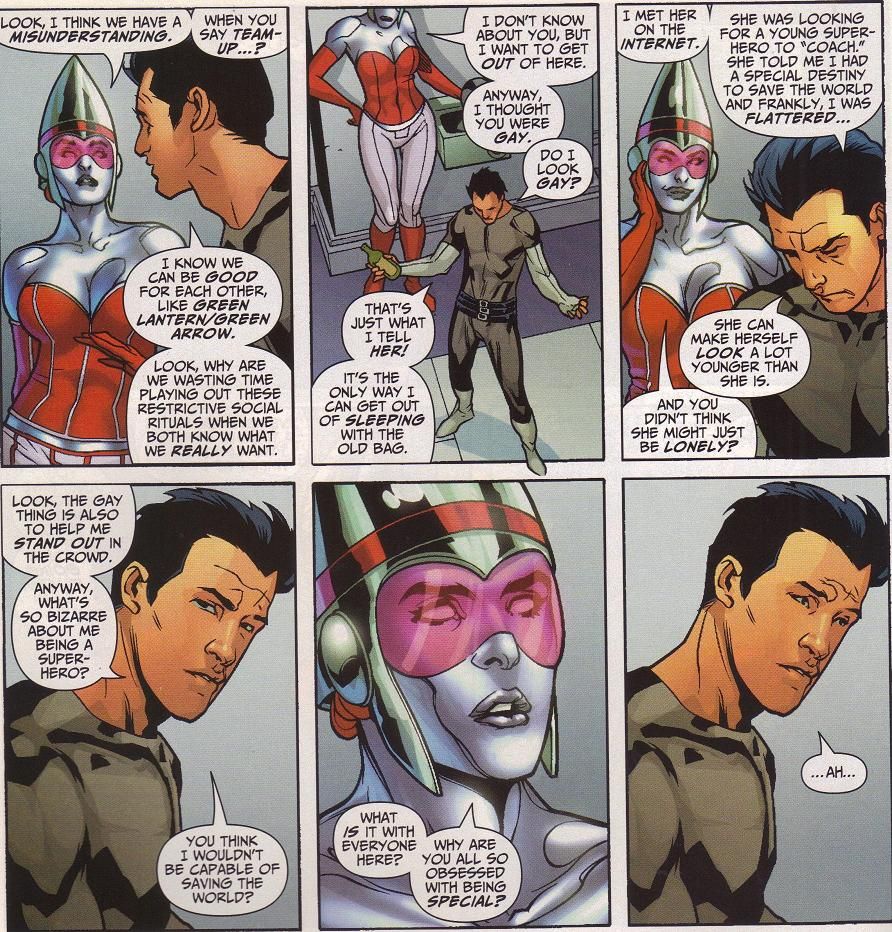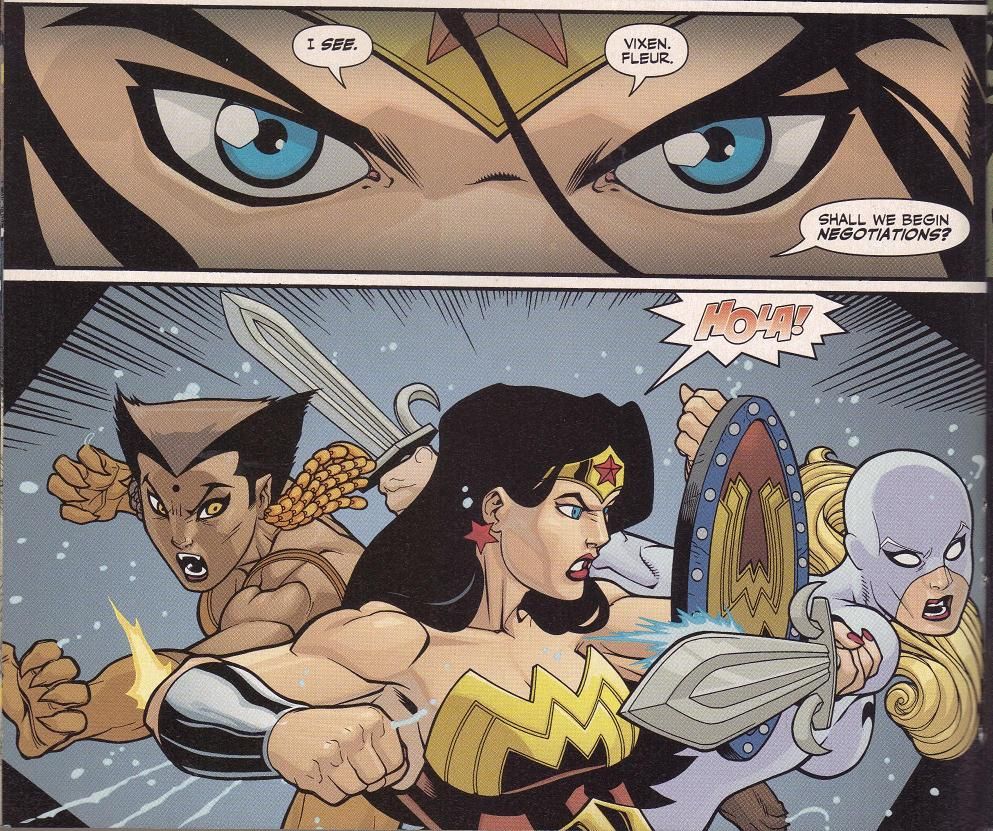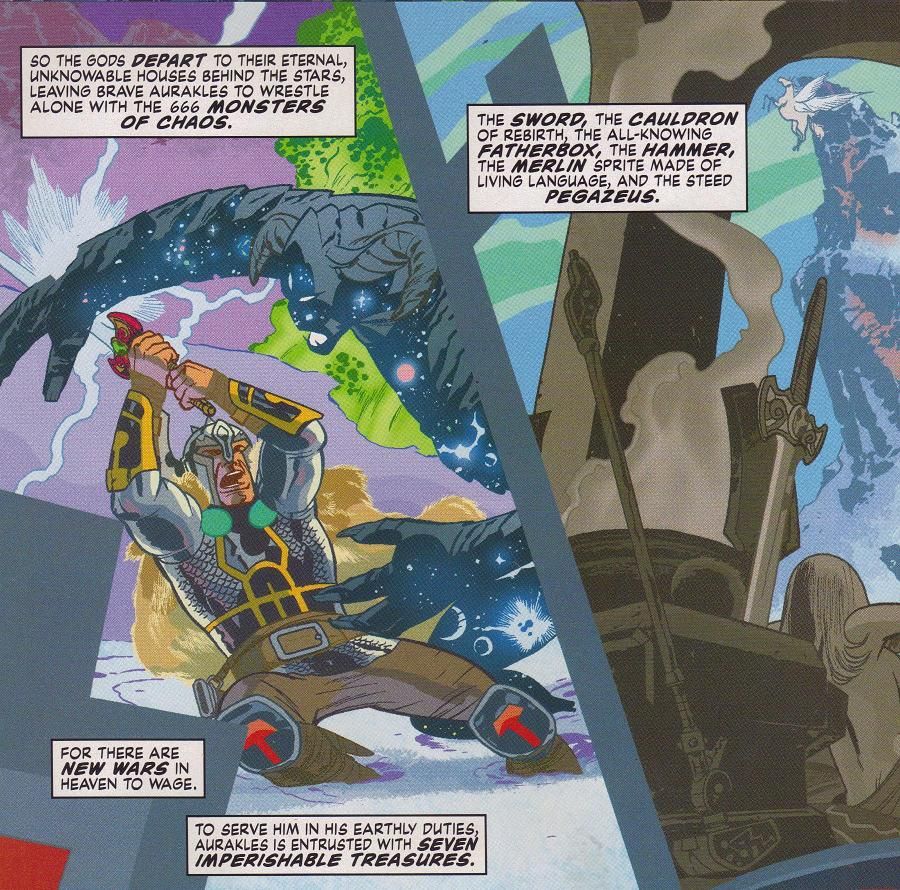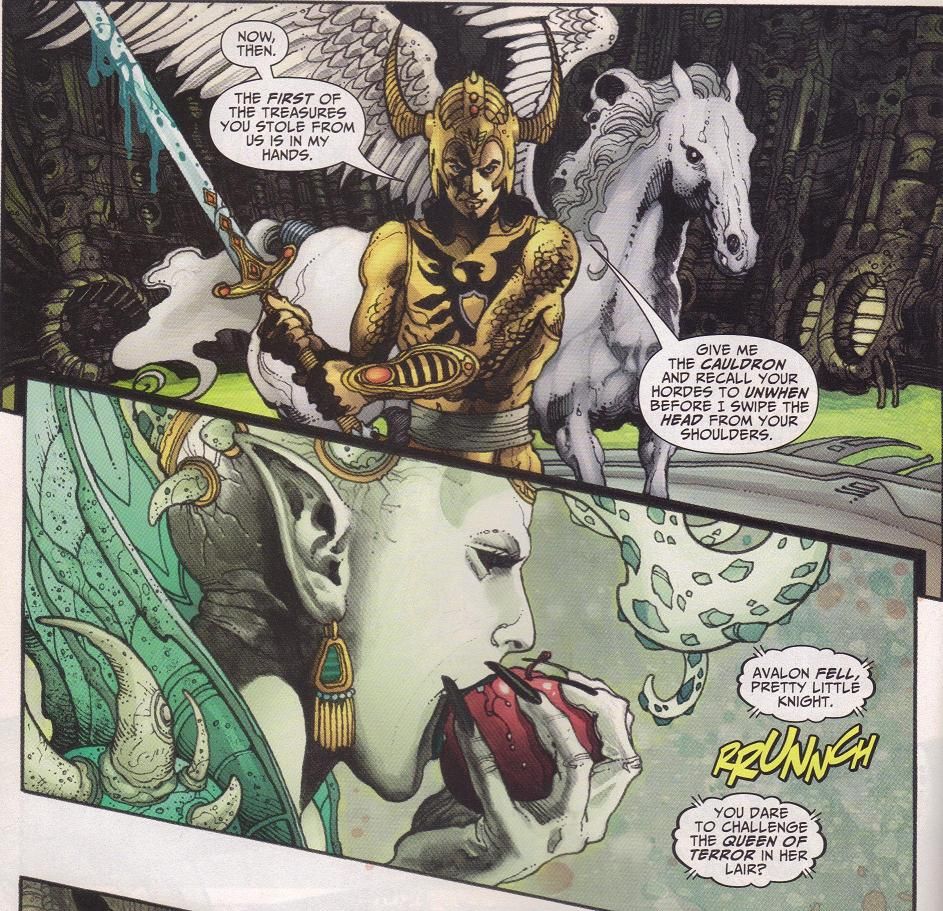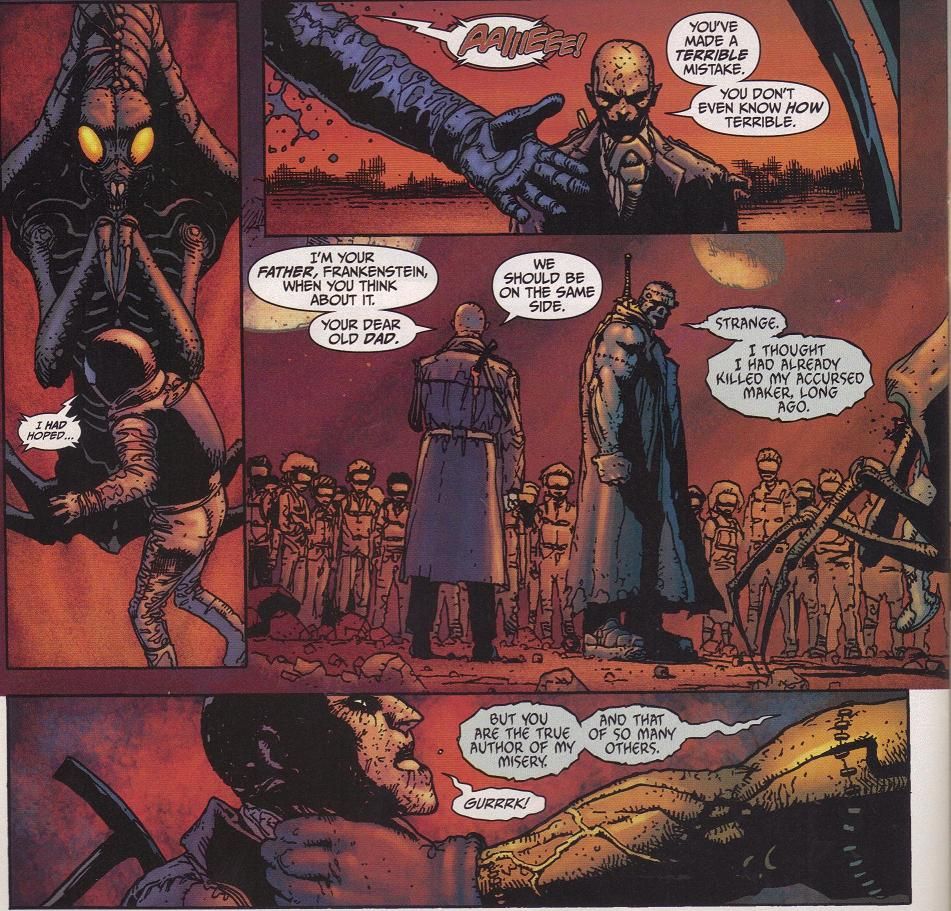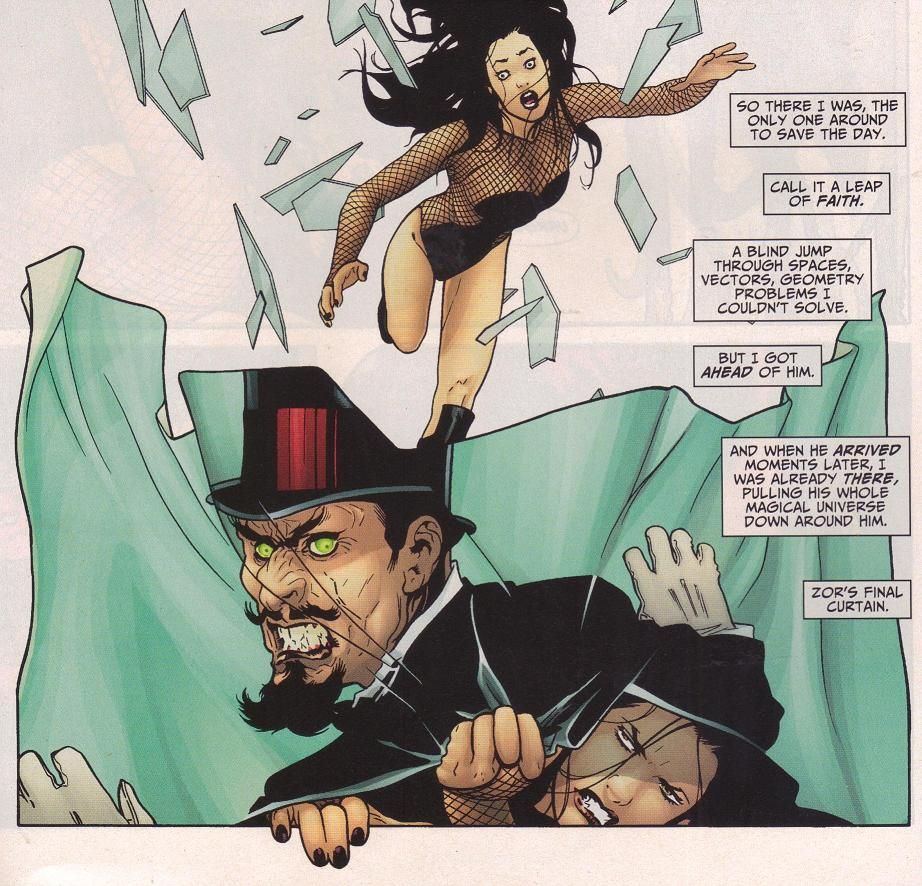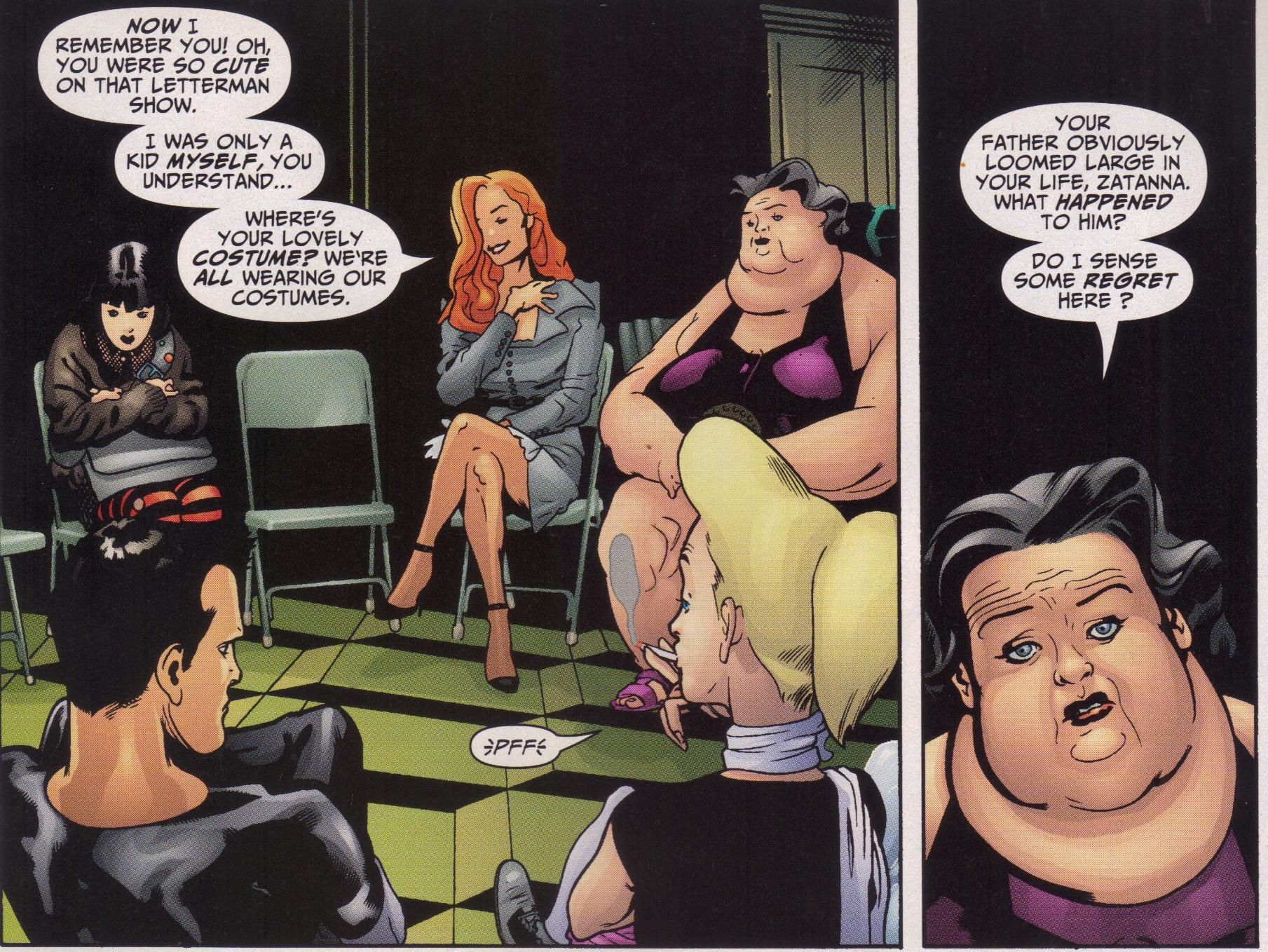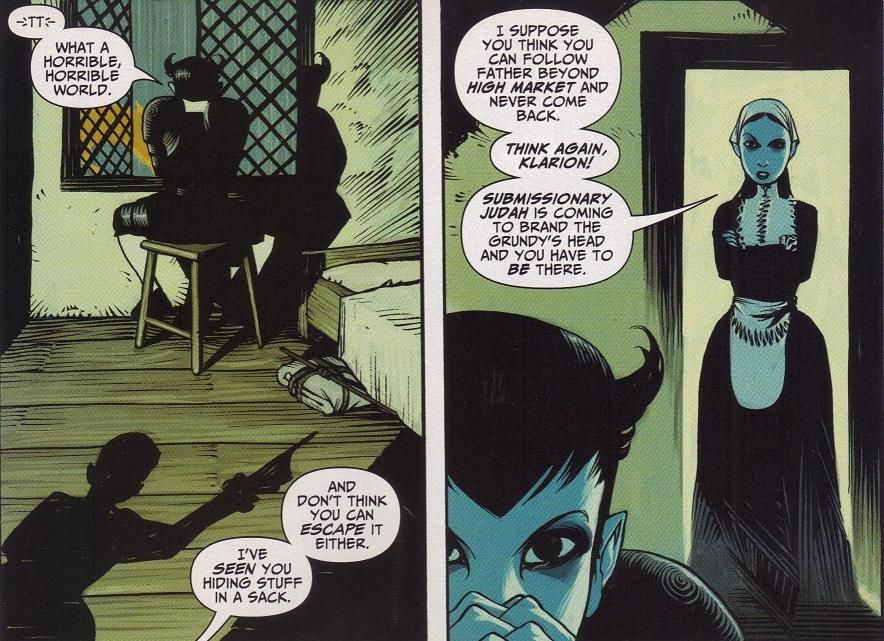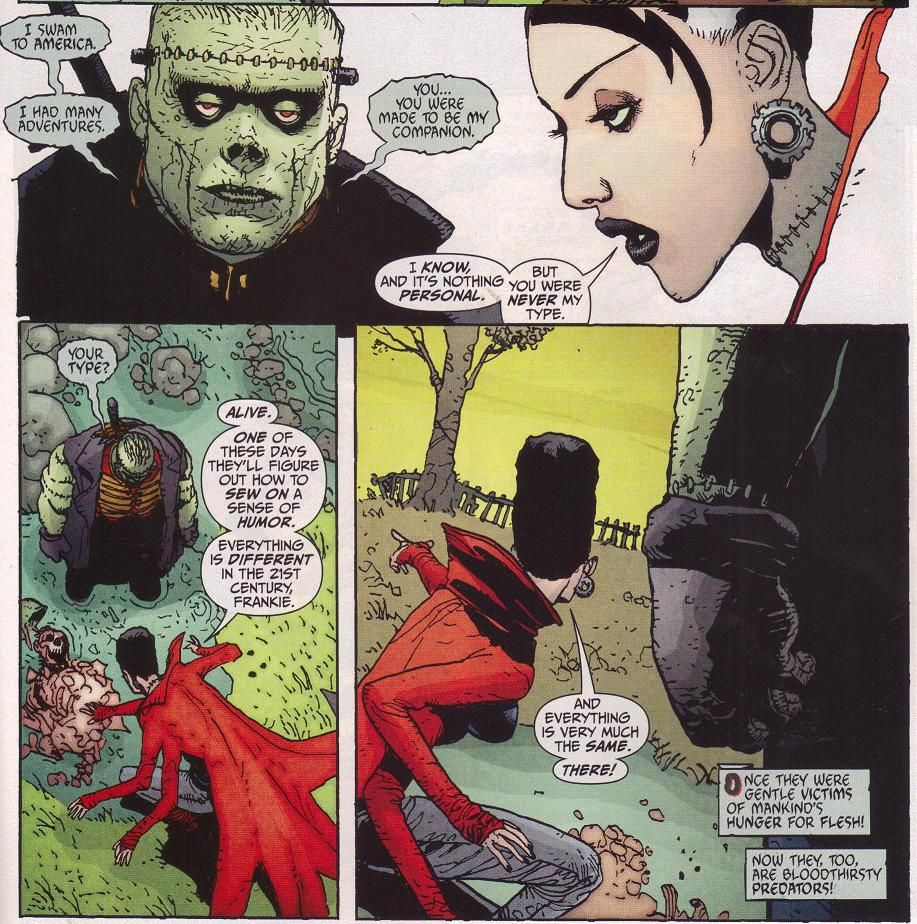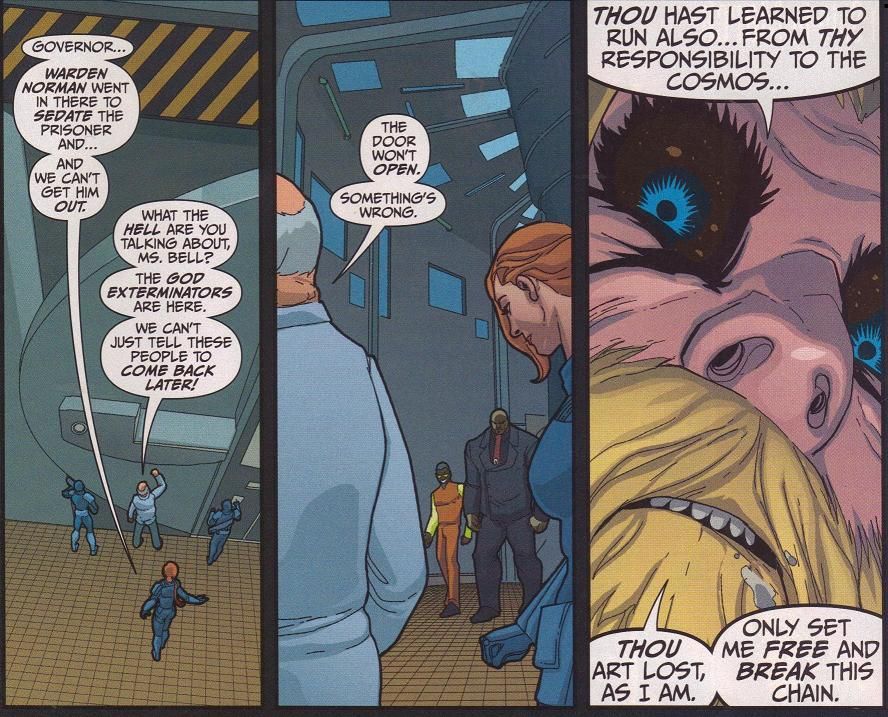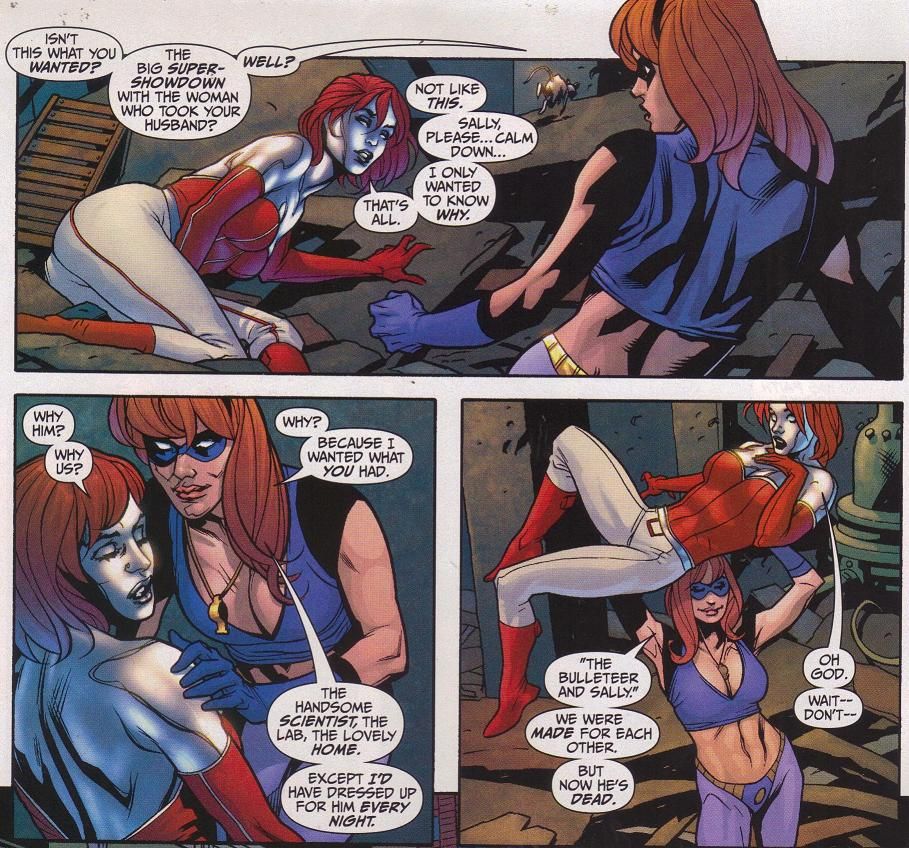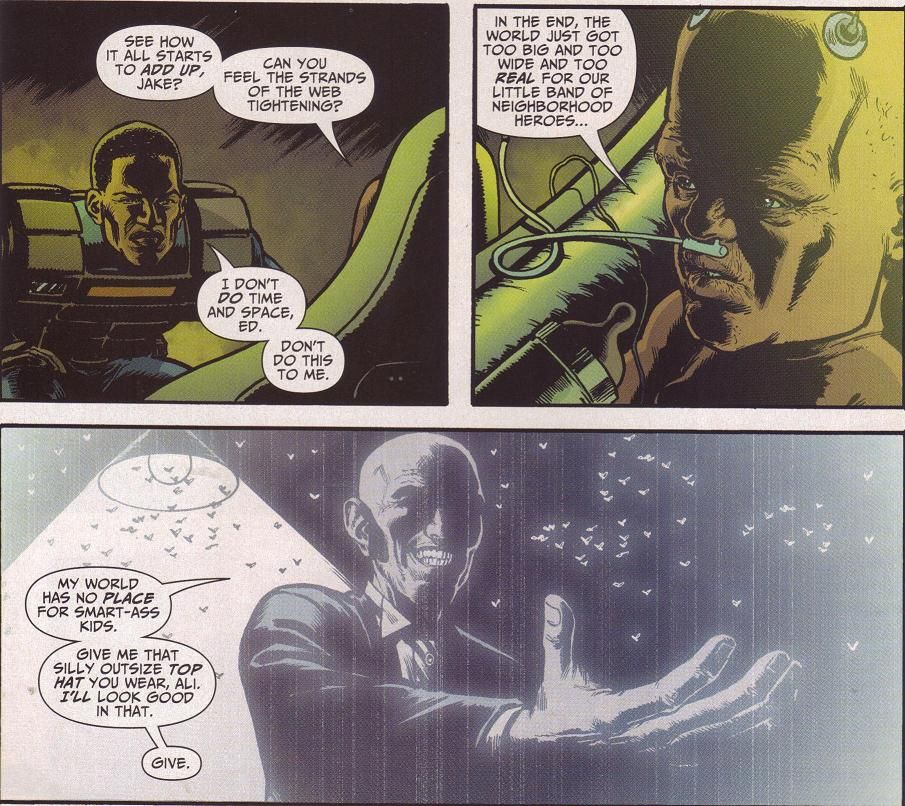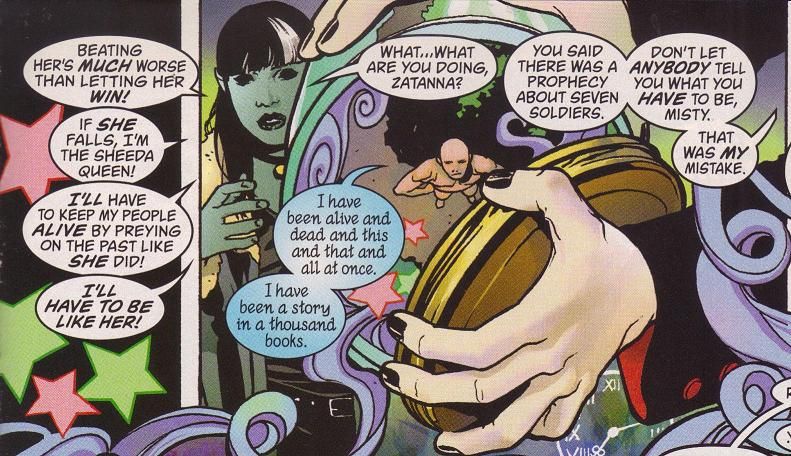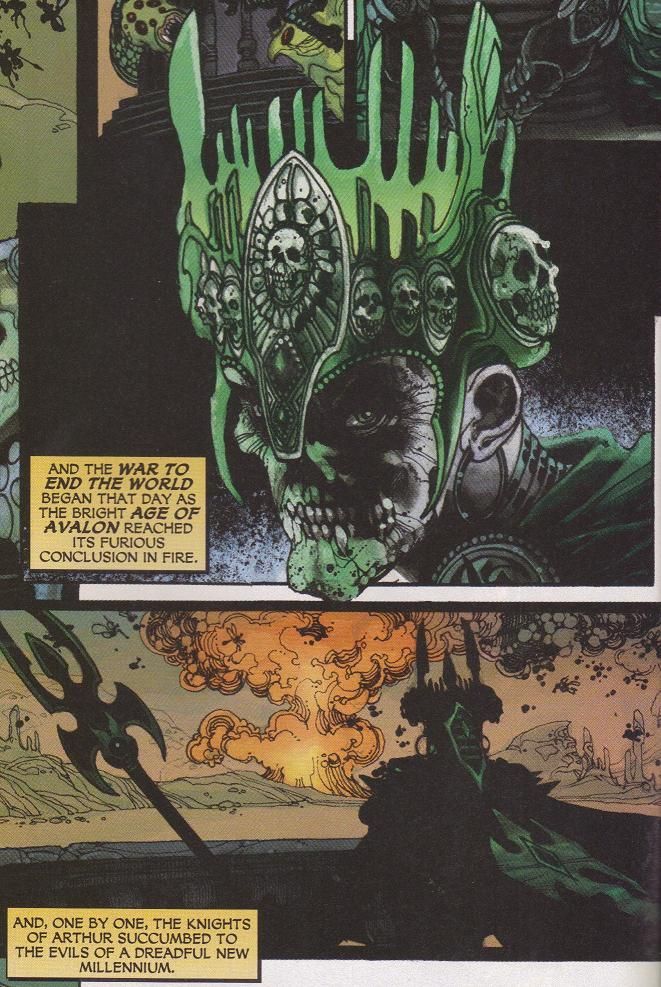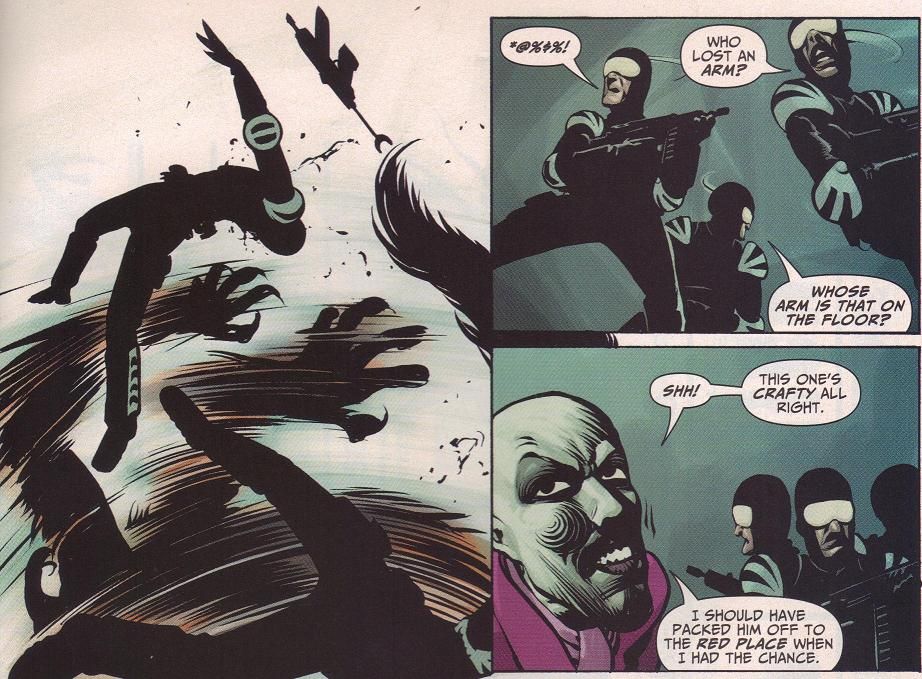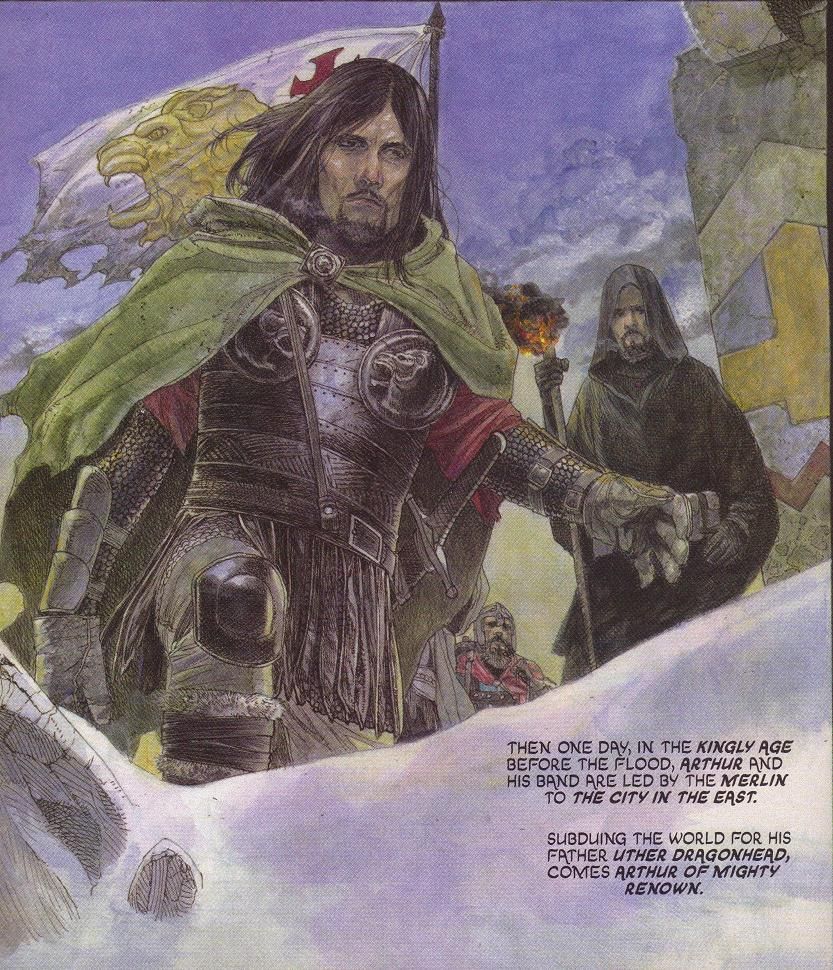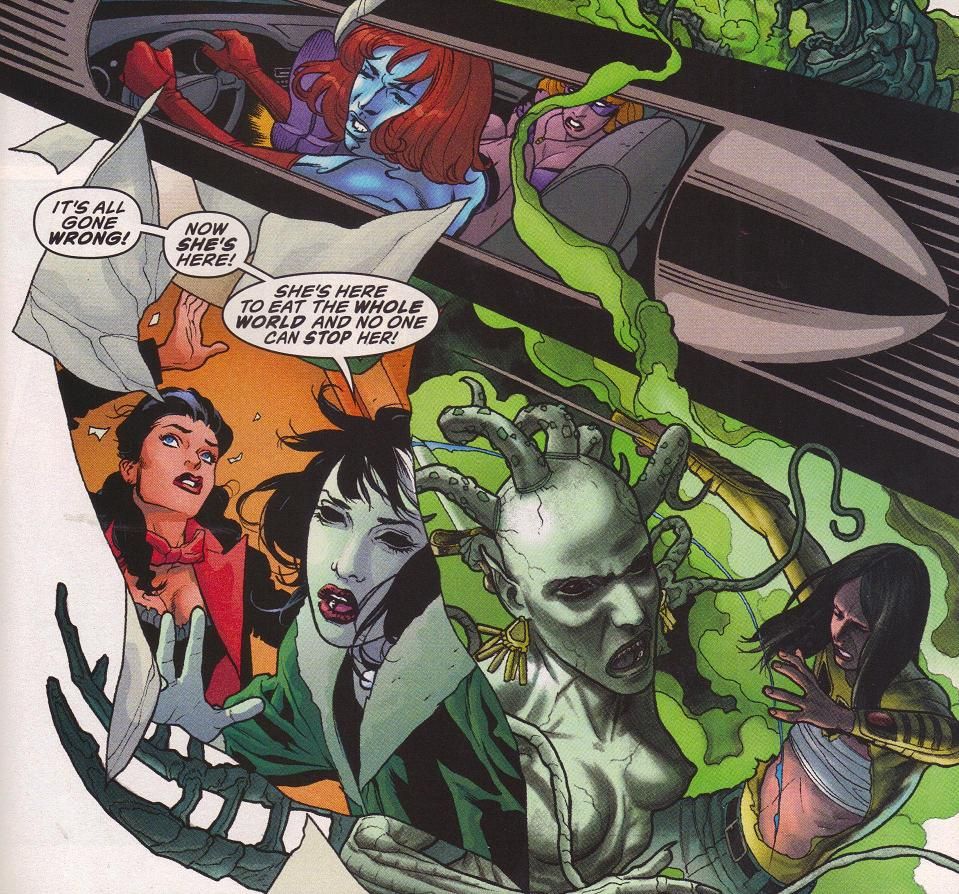Let the Whorrisoning recommence!
Seven Soldiers of Victory by Grant Morrison (writer), Ed McGuinness (penciller, JLA: Classified #1-3), J. H. Williams III (artist, Seven Soldiers of Victory #0-1; colorist, Seven Soldiers of Victory #1), Simone Bianchi (artist, Shining Knight #1-4),
Cameron Stewart (artist, The Manhattan Guardian #1-4), Ryan Sook (penciller, Zatanna #1-4), Frazer Irving (artist/colorist, Klarion #1-4), Pasqual Ferry (artist, Mister Miracle #1), Billy Dallas Patton (penciller, Mister Miracle #2), Freddie Williams II (artist, Mister Miracle #2-4), Yanick Paquette (penciller, Bulleteer #1-4), Doug Mahnke (artist, Frankenstein #1-4), Dexter Vines (inker, JLA: Classified #1-3), Mick Gray (inker, Zatanna #1-4), Michael Bair (inker, Bulleteer #1; Mister Miracle #2), Serge LaPointe (inker, Bulleteer #2-4), Dave McCaig (colorist, JLA: Classified #1-3; Mister Miracle #1-4), Dave Stewart (colorist, Seven Soldiers of Victory #0-1; Shining Knight #2-4), Nathan Eyring (colorist, Shining Knight #1; Zatanna #1-4; Frankenstein #4), Moose Baumann (colorist, The Manhattan Guardian #1-4), Alex Sinclair (colorist, Bulleteer #1-4), John Kalisz (colorist, Frankenstein #1-3), Phil Balsman (letterer, JLA: Classified #1-3; Bulleteer #1-2, 4; Frankenstein #1-4; Mister Miracle #3), Todd Klein (letterer, Seven Soldiers of Victory #0-1), Rob Leigh (letterer, Shining Knight #1-4; Zatanna #2), Pat Brosseau (letterer, The Manhattan Guardian #1-4; Klarion #1-4; Mister Miracle #1), Jared K. Fletcher (letterer, Zatanna #1, 4; Bulleteer #3), Nick J. Napolitano (letterer, Zatanna #3; Mister Miracle #2), and Travis Lanham (letterer, Mister Miracle #4).
Published by DC, 33 issues (JLA: Classified #1-3, Seven Soldiers of Victory #0-1, Shining Knight #1-4, The Manhattan Guardian #1-4, Zatanna #1-4, Klarion #1-4, Mister Miracle #1-4, Bulleteer #1-4, Frankenstein #1-4), cover dated January 2005 - December 2006, although there was a six-month gap between the end of Frankenstein in May 2006 and Seven Soldiers #1 in December 2006).
So, yeah, FAIRLY BIG SPOILERS ahead. I don't spoil the small things that make up the grand puzzle, and I tried to keep the big ones to a minimum, but that's the way it goes. Sorry!
One of the things that makes Grant Morrison such a great writer is his ambition, and Seven Soldiers might be his most ambitious project yet.
It's a marvelous achievement, a full-bore superhero crossover that puts so many others to shame, as Morrison takes his seven heroes and creates a world inside the regular DCU that seems slightly odd and slightly off. He writes seven different mini-series that interlock in only the most oblique manner, but he manages to keep them on point until his big conclusion. Plus, he manages to walk a nice balancing act with regard to the idea of a "team" whose members never actually meet each other. Some of the heroes cross paths briefly, but this really is seven heroes fighting the same threat almost accidentally, coming at the threat from different angles. Considered from a purely technical standpoint, Seven Soldiers is breathtaking.
In December 2006 (bleeding over to 1 January 2007), I did a series of posts on this series called "31 Days of 7 Soldiers." Those posts were incredibly detailed, and I'm not going to go into as much here, and I'll probably repeat some of what I wrote then. I'm not going to go over the crossword puzzle, for instance, but that's just Morrison being Morrison, so I don't think it's that important. So I encourage you to check those posts out if you really want to get into a page-by-page breakdown of every issue. Maybe I'll revive those at some point and we can all geek out once again.
The fascinating thing about Seven Soldiers is how Morrison keeps the big guns of the DCU out of the picture, which is something that writers always need to deal with when there's a world-shattering epic happening in one comic that doesn't seem to affect any other aspects of the shared universe.
Most writers simply ignore it, but not the God of All Comics! So we get a three-issue prologue to the entire saga in JLA: Classified, which introduces the Sheeda to the comic book world. Neh-Bu-Loh, an old Justice League villain from the early 1970s who defeated the original Seven Soldiers of Victory, is re-imagined by Morrison as an "adult" version of a universe called Qwewq and the huntsman of the Sheeda, a people who resemble evil fairies and who like to ride around on insects (occasionally they're small, occasionally they're "normal-sized"). He enlists Gorilla Grodd in his scheme, which involves luring the Justice League into his infant form and trapping them there and then using the Sheeda - who can control minds - to seize the Ultramarines (Morrison's updated version of the Global Guardians) and turn them into weapons. It sounds more complicated than it is. When the Justice League inevitably defeats Grodd and Neh-Bu-Loh, the huntsman tells Superman, "When next my people come, it will be as whispers of death, unseen ..." This sets up the epic proper, as Neh-Bu-Loh and the Sheeda come in secret to destroy the world. The Justice League and other heroes don't know what's happening until it's too late, and so Morrison's Seven Soldiers are the only ones who can stop the Sheeda. It's a clever device, and Morrison uses it well.
The way Morrison structures the series is interesting, too. He wanted them read in a certain sequence: Seven Soldiers #0 is first, of course.
Then, in order, Shining Knight, The Manhattan Guardian, Zatanna, and Klarion, reading each #1 in that order, and only then continuing on to Shining Knight #2 et al. After reading The Manhattan Guardian #4, read Mister Miracle #1 before returning to the final issues of Zatanna and Klarion. Then read Bulleteer #1 and Frankenstein #1 before Mister Miracle #2, continuing on from there. After Frankenstein #4, read Seven Soldiers #1. This is how they were released originally, and it's how Morrison intended them to be read. You can read each mini-series straight through, of course, but it's far more interesting to move through Morrison's epic in the way he wanted you to (it appears the trade paperbacks are collected this way, too, so that's nice). What it does is allow the reader to make some nice connections. In The Manhattan Guardian #2, for instance, the subway train on which Jake is fighting the underground pirates runs over a "monster." Only two issues later, in Klarion #2, we get that scene from a different perspective, and while we'd read it eventually if we read the entire mini-series before moving on to the next, it's fun how Morrison shows when these events are happening and how they connect to each other. It's a very deliberate structure, and it's impressive that Morrison is able to keep it all together.
As with almost every Morrison comic, there are certain themes that he likes to explore, especially when he's working with superheroes. Morrison loves superheroes, so even when his tone gets dark (as it often does), he's able to spin on a dime and show the wonder of superheroes. So in JLA: Classified we get human-eating Grodd, which is a serious tonal shift from how Grodd is usually depicted, but we also get Batman's "sci-fi closet," in which he hides the toys he doesn't want Alfred to tell the Gotham City police about.
This kind of balancing act is present throughout the epic, as the Sheeda do horrible things even as Morrison shows us superheroes being heroic, the Newsboy Army hearkens back to the Golden Age even as Morrison "modernizes" their problems, and we get goofy concepts like the subway pirates but plays them deadly seriously. Morrison often does something interesting with his superheroes - in order to show their glory, he grounds them firmly in a world where superheroes are almost banal. In Seven Soldiers #0, we meet Shelly Gaynor, who has become a superhero so she can write a book about being a superhero. We've seen Morrison's metatextual take on superheroes before, and this is just another iteration of that, but it's a fascinating one. Shelly decides to head to Arizona to help Greg Saunders, the original Vigilante, take on the monster of Miracle Mesa. She's been play-acting, but she's self-aware enough to realize that something has changed: "How do you know when you've become a superhero and not just a crazy fetish with a death wish?" she thinks. "Is it when the joke becomes real?" When they actually fight the monster - a giant spider, heralding the return of the Sheeda - she thinks, "My apartment and my fears about money and the future and never being good enough ... compared to this, everything seems so fucking stupid and unreal." Morrison, more than almost every other writer, links superheroing to sex and addiction, so behind the wonder of it there's always something a bit disturbing. Shelly dies horribly, but would she have traded those last moments and the rush they provided for a long, safe life? Meanwhile, her teammates are typical Morrisonian heroes - there's a Golden Age hero revamped a bit for the modern age (Greg Saunders, who isn't really revamped, just brought out of retirement and used to contrast today's heroes with those of the Golden Age); Jacqueline Pemberton, the daughter of Merry Pemberton, another Golden Age figure - the Girl of 1000 Gimmicks; Boy Blue, who turns out to be the nephew of Ramon Solomano, the Iron Hand, who originally called forth Neh-Bu-Loh back in the early 1970s to destroy the Golden Age Seven Soldiers and who betrays the team but dies anyway; Dyno-Mite Dan, who bought "Golden Age mystery rings" on-line; and I, Spyder, who is an uncanny bowman who appears later in the epic as a slave of the Sheeda.
These are the original "Seven Soldiers" - there are only six of them, because the Bulleteer was supposed to be part of the team but canceled at the last moment - and it's interesting how Morrison constructs the team. Shelly and Dan aren't "real" heroes, they're fans who want desperately to be heroes. Jacqueline is also not a "real" hero, as she uses her gimmicks to be famous so she can tour the convention circuit. This kind of banality is evident in the most "superheroic" of the mini-series, Bulleteer, as Alix Harrower seems to be a conventional hero but she's not sure how to act like one. She finds out her husband is obsessed with keeping them both young, and he dies because of his obsession, while Alix discovers that he's been surfing superhero porn sites looking for girls even younger than she is (she's 27). Morrison introduces Sally Sonic, the girl with whom he was communicating on-line, and twists our expectations - she's a 75-year-old woman trapped in a teenager's body because she doesn't age, so she's miserable for a different reason than Alix. Alix's husband, Lance, thought he was obsessing over a teenager, but Sally is depressed because she's stuck as a teenager. Once again, Morrison shows us the weirdness of superheroing while still remembering that the weirdness can easily become disturbing. There are several other examples of this kind of dichotomy of superheroes in the epic, from Zatanna's "spellaholism" to the sad fates of the Newsboy Army, and Morrison is very good at it, switching from wonder to creepiness on a dime because he understands both the amazing aspects of being a superhero and the more unsavory parts of it.
Linked to the superhero theme is the theme of myth and legend, which is something else Morrison likes to delve into more than a lot of writers. One of the reasons I suspect he likes DC more than Marvel is because DC's heroes are so much more iconic than Marvel's, and Morrison loves examining these icons, both as characters and as their impact on the society in which they live (I could be completely wrong about why he's more of a DC guy than a Marvel guy - it's just a theory).
In the prologue to the epic, he gives us an Ultramarine Corps that is like a "Kingdom Come" version of the Justice League - they're a bit more arrogant (on the very first page of JLA: Classified #1, Warmaker One says "Wanna bet the International Ultramarine Corps can wrap this little insurrection up in ... what? Let's give it ten minutes? Who needs the Justice League?", words which of course come back to haunt him), they're not quite as good at their jobs, and they're more willing to kill the bad guys. Morrison contrasts them with the actual League, stuck in the infant universe of Qwewq (which is strongly hinted to be our universe), who refuse to openly approach Black Death because they're concerned about the psychic shock to the inhabitants of a world without superheroes. When they return, they have to fight the Sheeda-controlled Ultramarines, so Morrison can contrast them directly. After they beat the bad guys, Superman banishes them to the infant universe as punishment for their beliefs: "'Superheroes' who don't mind killing to achieve their ends can be dangerous in the wrong hands," he tells them, just after the Sheeda try to turn them into weapons for their use. The implication, of course, is that the icons of the DCU wouldn't have been so arrogant when they first encountered Grodd, thereby not getting sucked in by the Sheeda, or unable to be corrupted by the Sheeda. Either way, it's not very subtle by Morrison, but then again, it's just a warm-up act.
When we get to the actual Seven Soldiers story, the GoAC ramps it up even more. On page 1 of Seven Soldiers #0, Thomas Dalt (I, Spyder) is being ferried across Slaughter Swamp, and the oarman (Charon?) tells him a "local legend" about the black flowers of the swamp.
Dalt is transformed by the Time Tailors in the swamp, but we're not sure how until much later in the series. In the meantime, Shelly Gaynor and her group are trying to kill the giant spider of Miracle Mesa, and in addition to understanding the almost sexual thrill of being a superhero, Gaynor also understand the mythic component of it. Miracle Mesa itself isn't an exact place, as Greg Saunders tells her, "It's a legend. A place that comes and goes." It "revolves through many worlds" and is called "the hunting ground of gods." Gaynor is freaked out a bit, but when they actually find the giant spider of Miracle Mesa, she puts that behind her and thinks, "Is this what real superheroes feel? Is this it? This dreamy piling up of weirdness and the impossible. I'm chasing a legend. I'm all wrapped up in prophecy and myth." It kills her in the end, but is it worth it to her to become part of that legend? Morrison continually links superheroes to myths and legends, beginning 40,000 years ago, when the New Gods appeared on Earth and inspired the Neanderthals then living. In the Kirby-esque section of Seven Soldiers #1, Morrison writes that
the first of Earth's great heroes is born when the sky lords [the New Gods] mix together, in one incredible being, the traits of space god and Neanderthal warrior! ... The man-god is given a purpose and set to work to tame the ferocious Earth. To bring order and meaning where incoherence reigns. And this is mighty Aurakles. The original super hero.
As this is the DCU, legend and myth are a bit closer to "reality" than in our world, so while in our world, Aurakles might be a metaphor, in the DCU, he's an actual being, chained up in a basement.
His descendant, Alix Harrower, becomes the "spear that was never thrown" - she's a superhero who twice refuses to save the world - and Morrison makes it very clear that "prophecy" is driving the events, a fate no one can outrun or avoid.
Legend and myth are part of the other seven soldiers, too. Justin, the Shining Knight, steps from a Camelot even more legendary than ours, one that rose 10,000 years ago and was destroyed by the Sheeda. In Shining Knight #1, Morrison even links Gloriana Tenebrae (the translation of her name is, essentially, the Queen of Darkness), the ruler of the Sheeda, to the evil stepmother in Snow White, as she eats an apple and calls herself the "fairest of them all." He makes this connection more concrete in Zatanna #3, when our heroine and Misty, her new student, meet Neh-Bu-Loh. If his designation as "huntsman" didn't clue us in before, here Misty remembers that she is the queen's stepdaughter and Gloriana Tenebrae ordered Neh-Bu-Loh to kill her, but he was too enamored of her and couldn't do it. So Morrison takes the fairy tale and gives it a far darker spin - if Misty accepts her destiny and defeats the evil queen, she must take the queen's place and become exactly like her. It's a dilemma that the fairy tale never had to confront - Snow White didn't have to harvest other civilizations for hers to survive, but that's what the Sheeda need to do. Morrison twists the legend so that it becomes a much more interesting morality tale, which also allows Zatanna to be Misty's hero when she shows her a different way. Justin, meanwhile, also fights the queen, and Morrison reveals another "fairy-tale" twist - Justin is actually a young girl pretending to be a boy. This is a fairly old trope in fiction, but it's still interesting how it changes the dynamic - Justina loves Galahad, but she never reveals her feelings or even that she's a girl to him, and of course she is forced to battle him after the Sheeda enslave him. The fact that Justina is a girl also means her story parallels Misty's, in that both have a contentious relationship with the Sheeda queen that becomes a struggle between generations of women.
In the end, neither girl is corrupted, and a boy - Klarion - becomes the Sheeda king. His personality suggests he might be a bit different than what the Sheeda expect, however.
The other heroes spring from myths or unusual circumstances, although in the DCU, superheroes themselves are rather mythic. Frankenstein is a legendary tale of a man trying to create life; Klarion springs from the mysterious disappearance of an American colony; Jake Jordan is an ordinary man, sure, but he battles underground pirates and golems; Shilo Norman is an escape artist involved with the New Gods; Alix Harrower is, along with Jake, just a "normal" person, but of course she's a direct descendant of Aurakles. Morrison surrounds these heroes with plenty of ancillary characters who are as wrapped up in myth as they are, which is why he can examine so many different aspects of the theme. All of this ties into Morrison's love of superheroes, as these people must rise above their awful circumstances and become something greater than themselves. He's always been good at trying to expand the comic book beyond the confines of their paper borders, and while the most famous example of this is in Animal Man, he does it in Seven Soldiers, too. While some people might argue that he's gone to that well too often, he usually has a good purpose for it. In the case of this epic, he's trying to show how these heroes can step outside the cages of their own lives and broaden their experiences so that they're prepared for the horror that's coming. In issue #1 of Zatanna (which contains Morrison's not-so-subtle digs at Alan Moore), our heroine and her companions step outside panel borders and see themselves on other parts of the page. It's not that inventive, but it ties into Morrison's idea of the Sheeda standing outside time and history - he gives their rather convoluted origin in Seven Soldiers #1. Zatanna's ordeal in issue #1 helps her defeat Zor in issue #4, as she is forced to move beyond the panel borders again.
The Time Tailors stand outside of the universe, and they understand that Zatanna is a good choice for the Seven Soldiers because she's able to step "outside" as well. When she needs it, in Seven Soldiers #1, she's able to bring the "team" together without them ever meeting each other (well, that's not strictly true - Klarion meets Frankenstein, but only briefly, and Alix is standing next to Jake at one point, but it's not clear if they ever speak to each other). Justina steps outside the panel borders, as well, when she fights with Gloriana in Castle Revolving - again, Morrison is using this trope to show how the Sheeda step outside time and space, which once again ties back into the theme of everything becoming legendary. The Sheeda and Justina are no longer bound by the rules of physics, so the only way to explain them is to resort to metaphor. Morrison uses their battle outside the panel borders as that metaphor. When Shilo Norman is stuck in the "life trap," he has to break out, and while he doesn't escape the confines of the panels, he performs his greatest escape by coming face-to-face with an actual legend, Aurakles, who gives him the perspective he needs. Morrison shows that these heroes are moving beyond the restraints of their "world" - meaning the borders of the panels - because that's what heroes and legends do. They must become something bigger than the world to defeat the threat to the whole world.
Morrison ties this into the idea of a legacy, too. Many, many superheroes are legacy heroes, and Morrison has always shown an interest in the history of the DCU, so the fact that many of the characters in Seven Soldiers have to live up to a legacy isn't a surprise.
The Ultramarines, while "extreme" versions of the Justice League heroes, also feature Knight and Squire, Britain's Batman and Robin, and as this presages Morrison's work with Batman in which every story in Batman's weird history actually happened, the Knight - Cyril Sheldrake - becomes the son of the original Knight, who first appeared in 1950. Beryl Hutchinson, the Squire, is of course a legacy hero herself in two ways - she's an analog of Robin, but as the British Robin, presumably she will be in line to replace the Knight at some point. The generational hero comes more into play in the epic proper, as we discover in issue #0. Shelly Gaynor is a legacy hero - her grandfather was the original Whip - and when she meets the others, many of them are legacy heroes as well. I've already mentioned Jacqueline Pemberton, the daughter of the Girl of 1000 Gimmicks, and Boy Blue, the nephew of the Iron Hand, and although Morrison doesn't explicitly state who they are, we're reminded of the familial obligations with regard to Boy Blue, at least, when we find out in Bulleteer who he is. The epic is rife with legacies and what they mean, from Justin's legacy as a knight of Camelot trying to regain the golden age to Jake Jordan carrying on the fight of the Newsboy Army, from Zatanna trying to live up to her father's legacy and eerily replicating his death to Klarion's search for his father, from Shilo Norman's (unstated, but obvious) attempts to be better than Scott Free to Frankenstein's attempts to be a better man than his creator.
All of this drives the heroes forward. Jake Jordan is a legacy hero - although he's not really tied to any Manhattan Guardian who came before him, his story is most closely connected to the Newsboy Army, who connect the present to the DCU's past. His father-in-law, Larry, was not a member of the Army, but he was friends with them, so this also ties Jake to the DCU's past.
Zatanna spends a good deal of her mini-series trying to find the books her father wrote, and her regret over what happened to him and her yearning to see him again almost gets her killed when Zor ambushes her in the final issue. Klarion, of course, rebels against the Submissionaries of Limbo Town in part to find his father, and his tragedy is that he actually does find him, and it's nothing like he expected. Klarion and the other people of Limbo Town form a different legacy, as well, as they are descended from Melmoth, the Sheeda King, so in Seven Soldiers #1, Klarion is just seizing his destiny. Alix Harrower doesn't even know she's a legacy hero, but she's the direct descendant of the Earth's first superhero. Morrison is able to show different facets of the idea of legacy in this epic because he's dealing with so many different characters, and Alix explicitly rejects her legacy. When Greg Saunders approaches her to get her to fight the Sheeda, he tells her, "You can't quit when it's your destiny to save the world and send me to my rest." She replies, "I've tried really hard to make this work. I've tried to use my so-called super-powers for good. But I don't want anything more to do with this twisted, horrible world! I don't want archvillains or team-ups or my own special 'destiny,' you got that?" Of course, as this is fiction, Morrison doesn't let her escape her destiny even if she doesn't realize it, but her attitude is interesting, especially when compared to the enthusiasm for superheroing that the original team displayed. And, of course, had Alix been a bit more enthusiastic about being a superhero, perhaps the original team wouldn't have died because they would have had the requisite seven members. Frankenstein, of course, is not a legacy hero, but he is haunted by the idea of being better than his creator. In issue #2 of his series, he discovers that he too is a creation of Melmoth, as the Sheeda King donated blood to Victor Frankenstein so that his creation could live. Frankenstein is better than his creator, even though until that moment he didn't know who his creator is, and he overcomes Melmoth and ... well, doesn't kill him, but close enough.
Later he mentions to the Bride of Frankenstein that he took his creator's name so that in the future "it may perhaps be honored." Even as he tries to become the hero Victor Frankenstein never was, he still wants to redeem the name. He is defined by his legacy as much as any of the others.
The final main theme of the book has to do with growing up, which of course ties in with so many of the other themes (there are a lot of other motifs running through the epic, but if I went into those, we'd be here all day). Superheroes, Morrison recognizes, are an inherently immature thing, but that doesn't mean they're not worthy of examination. A lot of the tension in Seven Soldiers comes from this idea that people need to grow up but they also need to hold onto the wonder of youth. Morrison, as a writer, likes the Silver Age but also is good at digging into the weirdness behind the Silver Age goofiness, and he does that quite a bit in this saga. He does it most overtly, perhaps, in JLA: Classified, where I've noted that the Ultramarines are obviously examples of "extreme" heroes from the 1990s era of Big Two comics (with the possible exception of the Knight, who's not a Morrison creation anyway) and the Justice League stands for the stolid-yet-inspiring heroism of a simpler age (which Superman deftly explains in issue #3 is the kind of heroism the modern age needs). In Seven Soldiers #0, Morrison tends to focus on other aspects, but he does set up this theme in the prologue, when Tom Dalt is changed in Slaughter Swamp. The Time Tailors tell him that they'll get him "some cool new clothes" as part of his transformation. On its own, this is not a metaphor, but later, when the Tailors confront the Newsboy Army, the same words will take on a more sinister meaning. Morrison pokes some fun at Dyno-Mite Dan as someone who's spent "his entire adult life in chat rooms talking about super-powers, who's got 'em, who's lost 'em, and where to get some of your own."
Later, Dan tells Jacqueline that hunting the giant spider will "make a totally cool story for the convention circuit." This sets up the later issue of Bulleteer set at the convention, where Morrison is a bit harsher on fans (but not too much; he still believes in the power of comics, after all).
Morrison walks a fine line between the idea that adults are all evil and everyone should stay young because young people are awesome and the idea that everyone needs to grow up and mature to reach their destiny, but he does it well, reminding us throughout that there's nothing wrong with growing up as long as your soul doesn't die. Several of his characters struggle with this problem, and it's fascinating how they deal with it so many different ways. Justin, naturally, "grows up" in that he is revealed as a female, and she must stand and fail on her abilities and not because people think she's a man. In the first issue of Zatanna, we're introduced to Sally Sonic, but Morrison only begin to use her in Bulleteer so he can show how immature Lance Harrower is. Sally's dilemma is not only a metatextual commentary on superhero comics (it's significant that she's 75 years old and never ages, because that means she's been around since the Golden Age, not unlike Superman, Batman, and Wonder Woman), but also an example of a character who desperately wants to grow up but the world won't let her because of her outward appearance. She's ignored by the authorities and exploited by a man out for revenge against her father, and even Alix Harrower can't redeem her when she shows her some kindness because Sally is too far gone. Perhaps she would have turned out "evil" anyway, but the fact that her body never ages makes it easier to abuse her - as Dennis points out in Bulleteer #4, "She's twenty-six years old on the inside. So it's all above board, see? Little Goody Two-Shoes here could live to be a hundred and twenty and never look a day older than she does today." The fact that Sally can't "grow up" is what twists her inside. In other cases, Morrison implies that growing up is dangerous, but for Sally, it's the opposite. Klarion is another case of a character not growing up and this leading to dire consequences. The Puritans of Limbo Town dig up their dead ancestors and turn them into Grundys, a fate that makes growing up sound like something to avoid. Klarion is rebellious, a function of his youth, and that leads him into the world above, the world of Blue Rafters.
He doesn't want to turn into a Grundy, and when he meets his father, he decides he doesn't want to grow up if that means turning into a man like his father or Submissionary Judah or Melmoth. Melmoth, of course, grooms young people to "go red," and when they turn 16, they disappear. Again, this argues against growing up, as when they're "adults" they are sent to the mines on Mars, there to toil until they die (presumably). Why would Klarion want to grow up and do that? In the final issue of the mini-series, he rejects the leadership of Limbo Town and sets off on another adventure, which leads him to his fate as the new Sheeda King. Morrison implies that part of his betrayal stems from his refusal to grow up and accept his responsibilities, but there's also the hint that, because he still in the flower of youth, the Sheeda themselves might become less of a threat, as Klarion will reinvigorate them. In another mini-series, Zatanna herself has to "grow up" a bit - she's already an adult, of course, but she's living in the shadow of her father's death and her actions in Identity Crisis, when she helped "mindwipe" Dr. Light and Batman, ushering in an even darker age of so-called heroism in the DCU. In her mini-series, she's able to put the ghost of her father behind her, but she also mentors Misty Kilgore in magic, making sure that the girl doesn't want to become the evil Sheeda Queen as she's supposed to. By being a "parent" to Misty, Zatanna is able to grow up herself a bit.
The Newsboy Army is the most obvious manifestation of Morrison's examination of growing up. We meet Ed Stargard in The Manhattan Guardian #1, and while we don't know it yet, we soon discover that he's another person like Sally Sonic, in an even more extreme example - his body is a baby's, while his intellect is of an old man. Ed forms the contrast to Sally - he grew up "normally," in that he was able to become a successful publisher and keep the fight against the Sheeda going, and Morrison, in another theme of the series, implies that it's because Sally was, of course, a hot female while Ed was an ugly man.
Ed - as Baby Brain - was a big part of the Newsboy Army, along with L'il Hollywood, Ali Ka-Zoom (who's a big presence in Zatanna), Captain 7, Kid Scarface (who as Don Vincenzo plays a big role in Shining Knight), Chop Suzi, and Millions the richest dog in the world. When Mo Colley gets possessed by the Sheeda, L'il Hollywood talks him down, but the police gun him down anyway. Hollywood gets blood all over her face, and Morrison implies that this traumatic event stayed with her to her tragic end. When they track down the Time Tailors in Slaughter Swamp, Morrison returns to the idea of putting on new clothes, but much more explicitly. The Army sees the Terrible Time Tailor (who's Zor, the villain from Zatanna #4), and he tells them that one day "kids like you won't be worth a damn." "My world," he says a few pages later, "has no place for smart-ass kids. Give me that silly outsize top hat you wear, Ali. I'll look good in that." Ed tells Jake that Zor had special clothes for them - "suits you'll wear when you're older" - and then we see the fate of the Newsboy Army - Vincenzo is a mass murderer, L'il Hollywood is an alcoholic, Ali Ka-Zoom is a homeless schizophrenic, Ed himself is a reclusive freak, Millions is dead (although Morrison later shows that this isn't true), and Chop Suzi is dead, presumably killed by Captain 7 after he raped her. This is the tragedy of growing up writ large - Morrison shows that for the Newsboy Army, growing up is horrific, but by allowing the three adult members who actually show up in the epic to continue their fight against the Sheeda, he shows that adults can actually still remain heroes, as long as they remember the glory of youth (I should point out that L'il Hollywood does get a cameo as an adult, but she doesn't do much). As with all of these characters who are either trapped in childhood or grow up to be "evil," Morrison's point seems to be that there needs to be a youthful exuberance even as we get older. The ultimate expression of the idea of adulthood leading to the death of the soul is the Sheeda themselves. They are the final civilization on Earth, and their innovation and creativity is long dead, so they strip-mine the past for their inspiration and society.
This is why Gloriana orders Neh-Bu-Loh to kill Misty, of course - Misty represents youth, and as Gloriana plans to live forever, she doesn't need an heir. But her immortality comes at a price - she is decrepit and stale, and her civilization reflects that. Gloriana tries to justify her actions - in Frankenstein #4, she tells the monster, "Humankind has ever preyed upon the Earth, and we are only the last link in that chain -- we super-survivor organisms." Later she says, "Would you have our people starve, thou very moral monster? Is it not our right to grow fat on the debris of a self-destructing civilization?" She has a point, but Morrison shows that this civilization survives because it can still muster its heroes, who represent the spirit of youth no matter how old they are, and therefore they're able to turn back the Sheeda.
All of this Morrisonian goodness might have been blunted a bit if the God of All Comics hadn't been able to work with some stellar artists, most of whom fit the tone of the books perfectly. While not technically part of the Seven Soldiers saga (although I, of course, think it should be), the JLA: Classified arc features Ed McGuinness's muscular superhero art, and McGuinness is talented enough to do some interesting things with page layouts that most writers don't require him to do. On one page, Glob dominates the scene, and McGuinness puts the other characters on the page in drops of liquid that seem to flow from Glob himself. When Warmaker One and The Master first see the infant universe of Qwewq, McGuinness puts three panels as if they're faces of a cube, in which shape the universe appears.
McGuinness doesn't do anything too radical when we check in on the Justice League inside Qwewq, but he creates a 16-panel grid to show snapshots of their exploits, implying that showing them completely would psychologically damage the universe. He probably draws the coolest Neh-Bu-Loh, too, so there's that.
In the main epic we get Simone Bianchi, Cameron Stewart, Ryan Sook, Frazer Irving, Yanick Paquette, and Doug Manhke (yes, one mini-series is missing, but I'll get to that). Bianchi is a perfect fit for Shining Knight, because his baroque style works well for the story of knights and flying horses and strange creatures. He draws a particularly evil Gloriana, and Nathan Eyring does a marvelous job coloring her so that she looks like death. Bianchi's biggest problem is always storytelling, as his pages tend to be a bit cluttered and confusing, but because of the ornate tone of Shining Knight, it works far better on this mini-series than it does on, say, Bianchi's almost unintelligible Marvel work. Cameron Stewart, meanwhile, is a superb artist for The Manhattan Guardian, as his design work tends to be fairly solid, which helps sell the weirdness of the characters better. His cleaner line also makes the story of the lost innocence of the Newsboy Army much more powerful. This series, along with Bulleteer, is more "super-heroic" than the others, and Stewart's powerful lines keep the book grounded. Sook was probably the best choice to draw Zatanna if J. H. Williams wasn't available (which he obviously wasn't), because the first issue is so much a satire of Promethea, and Sook's pencil work is delicate and chameleonic enough to remind us of Williams's work on that comic without aping it blatantly.
Sook has always shown a versatility that comes out well in the layouts of the mini-series, not just in the dazzling first issue. The battle against Gwydion in issue #2 is wonderfully choreographed, and the metatextual aspects of issue #4 demand someone with a crisp line so Zatanna can tear it all down, and Sook nails it. Frazer Irving's contributions to Klarion cannot be overstated, as he's completely in his element with the Puritans, the odd creatures in the sewer, Melmoth, and the Grundys. His characters always have a dour mien about them even when they're happy, and Irving is excellent with creepy stuff, so Melmoth looks far more disturbing than when Doug Mahnke draws him (and that's not to say that Mahnke doesn't do a good job with him, but the combination of Melmoth's creepy face and his weird smile when Irving draws him makes him a creature from nightmares). Irving's colors are superb, too, as he uses blues in Limbo Town to make it a dreary place and contrast it well with the brightness of Blue Rafters. Yanick Paquette, who hadn't yet blossomed into the tremendous designer that we see in the DCnU Swamp Thing but was still a very good penciller in 2005, is a fine choice to give us the cheesecake of Bulleteer, which the series needs so that Morrison can subvert it. Like Stewart, Paquette's clean artwork is stereotypically "super-heroic," so for a book about a true-if-reluctant superhero, an artist who can give readers what they expect to see even as the story undercuts it is a good idea. Finally, Doug Mahnke's rough lines and penchant for oddities make Frankenstein a wonderfully twisted mini-series. His weird teenager, "Uglyhead," in issue #1, is a stereotype, but Mahnke makes sure he has a pathos about him that makes his descent into madness more tragic. Frankenstein's sojourn on Mars in issue #2 is terrific, and back on Earth in issue #3, Mahnke is able to cut loose with all sorts of creepy-crawly things that drank the infected water. While Mahnke's Neh-Bu-Loh is a bit too top-heavy, his Gloriana is more monstrous than Bianchi's, which makes sense as Gloriana isn't trying to seduce anyone in Frankenstein, she's just trying to conquer. Of course, in all of this, Mister Miracle stands out like a sore thumb. It's the oddest mini-series, because it feels as if Morrison wanted to write a New Gods series but DC wouldn't let him unless he tied it into Seven Soldiers, and so it feels shoehorned in.
The art doesn't help, either. Pasqual Ferry is a fine artist, and his pencil work and layouts are fine in the only issue he drew, but he and Dave McCaig soften the art quite a bit, and it feels like the book needs a harder edge to it. Ferry also leaves several backgrounds empty, so the book, unlike the others, feels like it's taking place in some kind of dream world rather than New York. Freddie Williams II, who drew the final 2½ issues, has a stronger line and gives the book a better setting, but his super-hero style includes giving Shilo Norman fairly ridiculous muscles, which doesn't fit the character, and he lacks the chops to properly convey the majesty of the New Gods and someone like Aurakles. His cartoony style doesn't really fit the tone of the book, and while he's gotten a lot better in the years since, at this point in his career he seemed out of his depth.
Of course, J. H. Williams III anchors the epic with Seven Soldiers #0 and 1, the latter of which came out months late because when you put Morrison and Williams together, things just aren't going to get done in a timely fashion. Williams, of course, can effortlessly change his style, so in issue #0 we get a John Severin homage when Shelly Gaynor and Greg Saunders ride out on the mesas and we begin issue #1 with an astonishing Kirby pastiche as we get the story of Aurakles and the New Gods' arrival on Earth.
I want to say that his artwork when Arthur visits the Himalayas is a Hal Foster tribute, but I could be wrong. We get the newspaper artwork as the Guardian reports on the Sheeda attack, and Williams even manages to ape the styles of the artists working on the seven mini-series as the script moves from character to character. More than that, of course, is the way he designs a page and uses different media to convey a mood. In issue #0, he turns the panel borders into the roots of the trees in Slaughter Swamp, which slowly constrict Tom Dalt as he moves deeper into the marsh. When the six soldiers are in Arizona, Williams uses panel borders that are reminiscent of Southwestern Indian art, which ties into the Indian legend of Miracle Mesa. When he draws the Time Tailors in their mysterious house, he uses maze-like panel borders to indicate the layers of meaning and the impossibility of escaping one's fate when they become ensnared by the Tailors. In an extremely clever move (whether it was Morrison's or Williams's idea, I don't know), he shows the battle between Justina and Gloriana as taking outside the panels as the main action occurs in New York, showing that the two characters are fighting outside of reality as the queen's flagship moves backward in time. Williams's art is breathtaking throughout his two issues, which isn't surprising at all, but it's still nice. One very cool thing about this epic is that for the most part, you can simply look at the pages without reading them and still appreciate the effort the artists put into everything. That's not always true about all of Morrison's comics output.
Obviously, Seven Soldiers is as much a puzzle as it is a story, and I'm not going to get into all the connections and mysteries that Morrison casually drops into the saga. That's what my 31 Days of Seven Soldiers posts were about, in part.
But it is quite fun to work out the connections between all the series, and it's part of why the book is so good. Even without those, however, it's a true epic superhero story, one that stands out from among the many other superhero epics because it feels so much more, well, epic than those. It's not quite Morrison at his best, but it might be Morrison at his most accessibly clever. It presented DC with a golden opportunity to use some interesting new characters and some revamped old ones, and it's a bit of a shame that they've taken only sporadic advantage of it. Such is life, I suppose.
Seven Soldiers is collected in several trades, and they're "in order," as I noted above. JLA: Classified #1-3 is also collected, along with the JLA/WildC.A.T.s one-shot, which is probably there to fill it out. I wish DC would recognize that the Classified arc is intimately connected to Seven Soldiers, but I guess they're not going to. I'll tell you what, though - this would be a cool 1-2 volume Absolute Edition epic, as long as DC included the JLA stuff. All of this cool art in a bigger format? Hell yeah! In the meantime, you can read the trades and get lost in Morrison's wacky imagination. There are worse places to be!
Before I get to the next post, you can always browse through the archives. I've barely scratched the surface of the letter "S," so get ready for another comic beginning with that letter coming up next! Which one will it be? Beats me. But I'll get around to it soon enough!


